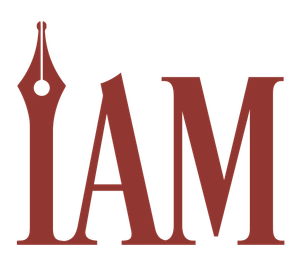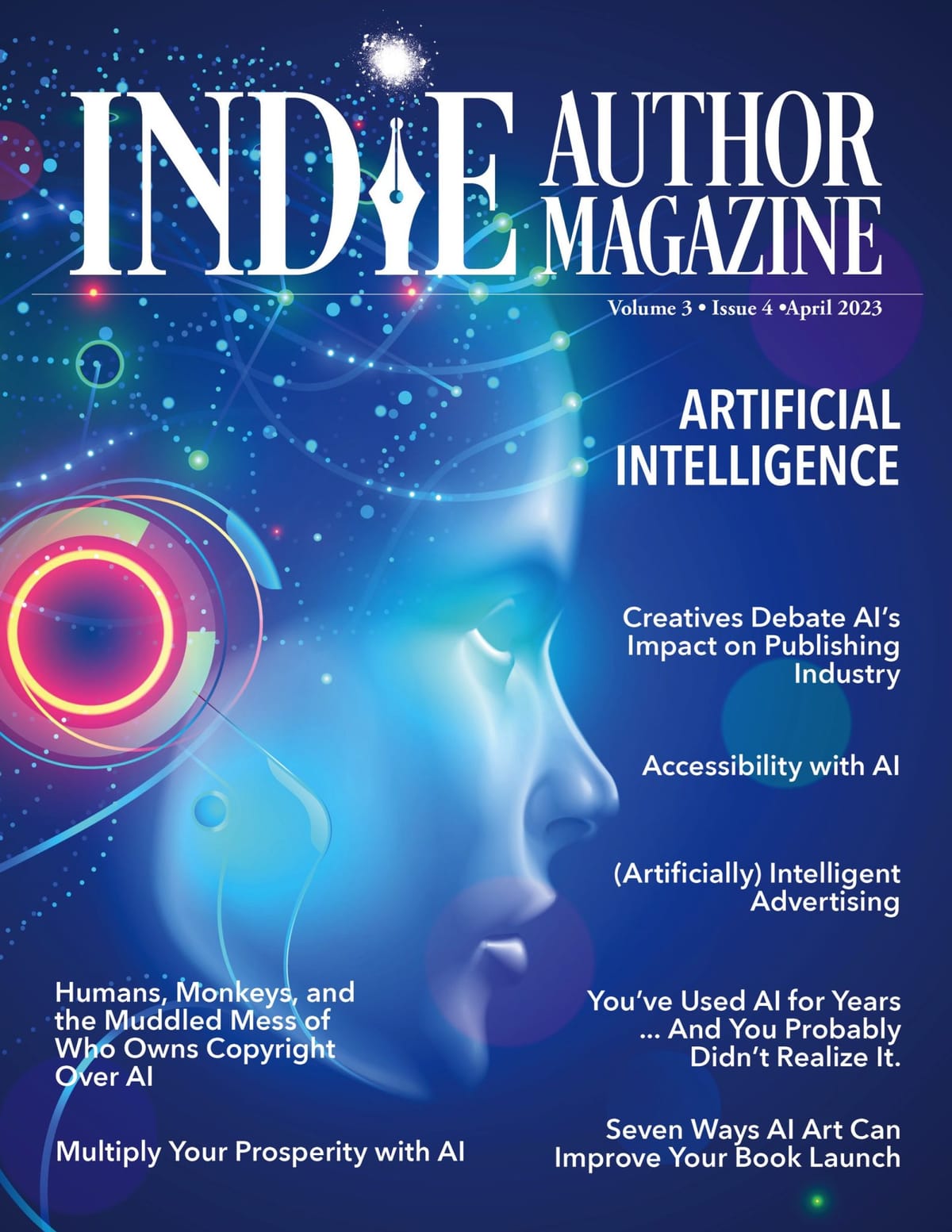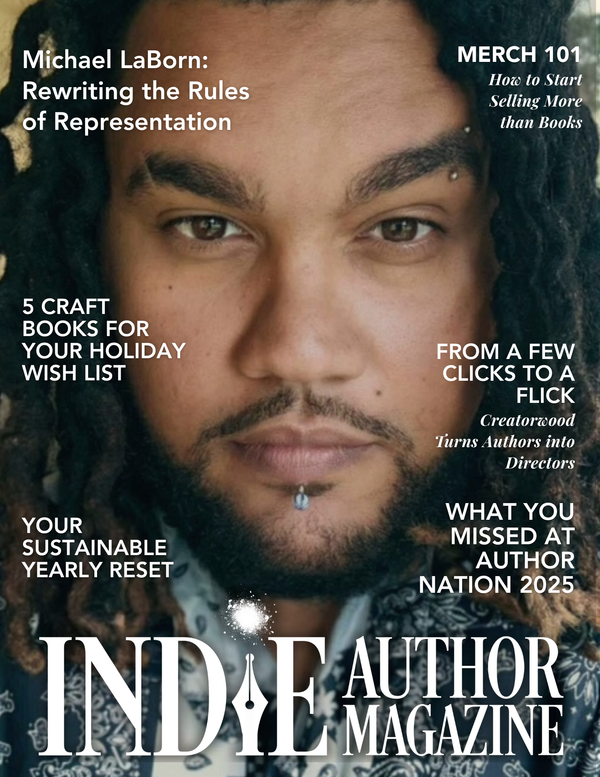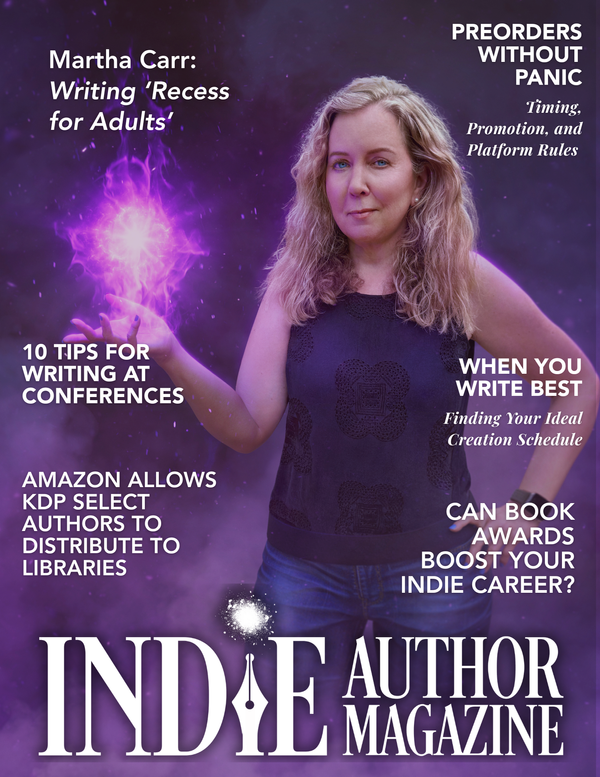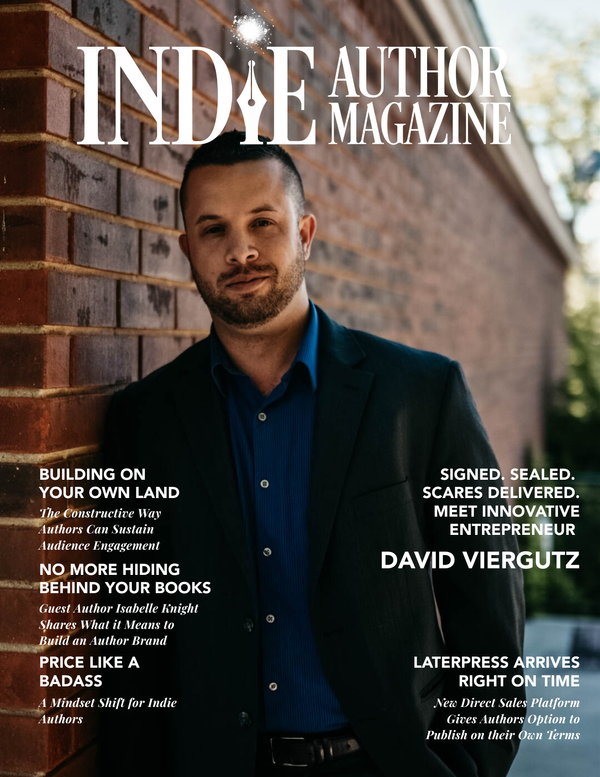Partner Spotlight
|
|
AI Tools for Writers: Boost Your Business
… And You Probably Didn’t Realize It.
Technology is constantly changing, yet rarely do we give a lot of thought to what powers that technology. Not so with artificial intelligence, or AI. With the recent surge in AI programs and their capabilities, people in multiple industries have expressed concerns about its potential impact on the workforce, especially in creative communities.
Some current concerns, such as the ethics of the ways some programs are trained, unemployment worries, and privacy issues, mentioned in articles by Forbes, The Harvard Gazette, and VentureBeat, are warranted. Yet it is also important to recognize that AI isn’t new. When a search engine prompts you with options as you type or when spell-check corrects your typo, you probably don’t bat an eye. But these functions are generated by AI, and they’re just two of the many ways we’ve already been using AI to make our lives easier for years.
Here are a few more ways AI has already played its part in your writing career and your daily life.
Grammarly: When you use Grammarly to check your spelling and grammar, AI helps determine errors and suggest corrections or ways to rephrase your sentences to make them more effective. The program also uses AI to determine your tone in the message and make suggestions to make it more or less formal, depending on your preference.
ProWritingAid: Similar to Grammarly, ProWritingAid is an online and desktop application that integrates with a variety of programs to enhance your spelling, grammar, and more. Not only does it perform standard grammar and spelling checks and suggest changes; it also now offers a rephrasing tool that will rewrite passive voice sentences to active voice when asked. It also checks for plagiarism, overuse of words or phrases, sentences containing too many words, and more.
Dragon NaturallySpeaking: Thanks to advances in AI, Dragon NaturallySpeaking—as well as Apple’s Siri, Microsoft’s Cortana, and other dictation and text-to-speech software options—can be trained to learn how you speak and transcribe more accurately in a short amount of time. In addition, users can train the program on any specific words it transcribes incorrectly. This additional accuracy makes it a go-to option for authors who use dictation regularly in their writing.
Adobe Photoshop: Adobe Photoshop offers users several options for automating corrections, including the program’s object selection tool, photo restoration filter, and one-click delete-and-fill tool for removing something in the foreground of an image. The tools incorporate Adobe’s own machine-learning AI, Adobe Sensei, to detect objects and make corrections, according to The Verge. Multiple Adobe platforms have incorporated Sensei since 2017, which has made programs like Photoshop more accessible and efficient to use, even for those without photo-editing experience.
Social media scheduling platforms: Many social media scheduling platforms provide suggested topics for people to use when creating posts based on holidays, recognition events, or memories they may want to share. Additionally, many social media scheduling platforms will tell you, based on when people interact with your posts the most, days and times on which to schedule posts, so they receive the most visibility and engagement. All of these suggestions are determined by AI that analyzes data over time.
Amazon and Facebook Ads: Amazon and Facebook Ads use auto-targeting to help you find your audience through their various channels. This targeting mechanism employs AI to do the work, with the only input coming from you, the author, when you set up and tweak the ads, audiences, and keywords.
Email spam filters and whitelists: It doesn’t matter who your email host is; almost all of them offer a feature that determines which email addresses or content are spam. Often, this determination results from AI that examines which emails you whitelist or block and learns accordingly.
Newsletter predictive sending: If you use predictive send for your newsletters, your provider is using AI to determine the best time to send your newsletter to specific email addresses based on open rates, time zones, and other information gathered by its system.
These programs are just the tip of the iceberg when you consider how much AI plays a role in our lives. Even though newer AI programs are making a stir in the author world, AI has been playing an essential and well-integrated role in writing and writing-related tasks for years without us realizing it.
Grace Snoke
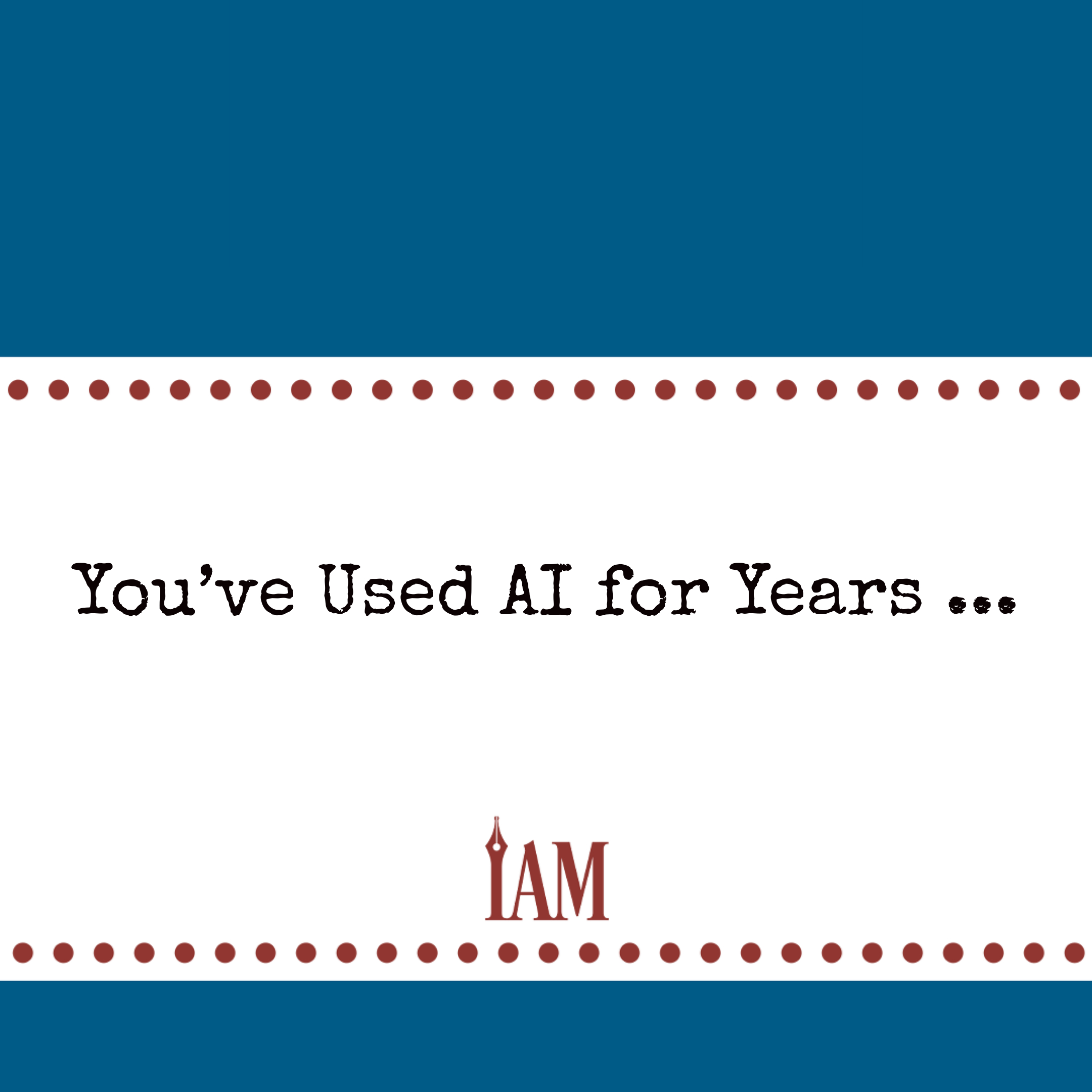
AI Tools Boost Writing Productivity for Indie Authors
How These Tools Became My Secret Weapon
Concerning. Frustrating. Scary. Terrifying. Horrifying. These are all words I’ve seen used to describe writing with AI in the last week alone. If anyone knows how to use words to rile up the author world, it’s fellow authors, right? But here are some other words I’ve used to describe AI to others: fun, exciting, inspiring, and helpful. AI has been all those things to me because AI saved me and my writing career this past year.
I’ve never been a speedy writer. I spend a lot of time mulling over my stories before I start writing. Often, I’m daydreaming while emptying the dishwasher or taking a shower, and those stories sit in the back of my head for months before becoming anything more than a few notes in Evernote. I have suffered from short-term memory issues for the last fifteen years, which means I have to really cement a story in my long-term memory to write it without forgetting it.
Before last year, I had been writing and publishing about three to four books per year. Certainly not a terrible output, but slower than many of my Sci-Fi Romance contemporaries who could write six to ten books annually. Still, I was happy with my progress.
Then I got sick with COVID. I tested positive in late April 2022 and was ill with cold-like symptoms and a sinus infection for two weeks. Still, the real problem was the months of lethargy and brain fog that followed. My short-term memory problems were ten times worse with COVID brain fog. I tried to write a book from May onward, and the process was devastatingly slow. Some days and weeks, I didn’t write at all. I could get in maybe one hundred to four hundred words when I felt a burst of energy. The book that typically takes me eight weeks to write took me over five months.
By then, I was exhausted from writing, and I cried to my husband that my writing career was over. The book was lousy. All the details were thin. My prose was dry, and I constantly repeated story elements because I couldn’t remember anything. I sat in despair until I remembered I had a subscription to this AI writing tool called Sudowrite. Maybe it could help me.
As I started using it and asking for AI’s help, the writing was suddenly fun again. Using Sudowrite was exciting and inspiring; it gave me good suggestions based on the Japanese culture in my books that prompted me to write something new. Description suggestions were rich with details, and the tools let me choose what I liked and discard what I didn’t. AI didn’t replace my work; it enhanced it. I was having a blast, and my five-month book was publishable in no time. I wondered if I could do it again from scratch, and I did a month later.
Now, I’m an AI enthusiast and run a Facebook group for other authors who want to learn the tools too. I’ve met countless others struggling to write because they have ADHD, fibromyalgia, arthritis, brain fog from chemo, or they’re fighting with some of the writing because it’s not their strong suit. These tools are helping them write again. Not all authors enjoy every part of writing. I excel with dialogue, but descriptions are tough for me. AI tools can help here, giving us the support we need in our weakest areas.
AI can be a powerful tool for authors. It won’t replace creativity but helps with inspiration, productivity, and efficiency. AI can also assist authors in becoming better writers by providing feedback and insights into their writing, helping them grow and prosper. Although there are some concerns about its implications, I believe AI is ultimately helpful and can be an excellent resource for authors. It saved me and my career, and I hope it can do the same for others.

AI Ethics in Publishing: Balancing Innovation and Risks
Without Ethical Standards, AI Poses Risks to the Creative Industry
As co-founder of the Future of Publishing Mastermind, people ask me about artificial intelligence (AI) a lot. Since I’ve been on several panels extolling the dangers of AI in creative industries, people think that I’m a Luddite.
However, that couldn’t be further from the truth. I literally co-founded a conference all about how to use technology and emerging strategies to grow your author business.
I kind of love AI.
Retail algorithms, after all, are AI, and they fuel the publishing industry.
AI helps us navigate the internet, and it’s responsible for advances I couldn’t imagine ten years ago. Right now, somewhere, engineers are coding an AI that will revolutionize everything again. Eventually that AI will be advanced enough to code itself to build something humanity can’t even imagine.
AI will likely be responsible for solving climate change, and there is nothing better at analyzing large data sets than artificial intelligence. Countless lives have been saved by implementing AI in the medical field.
That said, I do think the way that technology has been presented and integrated in creative fields is both dangerous and, frankly, dumb.
In other fields that work with AI, there are strict ethical standards about how they gather and process data. Whole jobs are devoted to making sure people maintain those high standards, not only in the procurement and analysis stage but also in the implementation stage.
Even with those ethical standards, AI makes a ton of mistakes. There are numerous studies showing AI can be biased at best and downright racist at worst, not to mention how often it is flat-out wrong.
That doesn’t even address the unethical way these companies gather and process information, by scraping artists’ and other creatives’ work from the internet to train their AI models without their knowledge or permission.
There are unintended consequences with every technology, and we have the ability to do better than our forebears when adopting something that could radically change the way we do business in overtly negative ways.
Bottom line, right now, AI is hurting a lot of creatives, and I don’t think it’s OK to step on the backs of creative people because it makes life marginally easier.
I don’t have an intrinsic problem with AI writing or art. I personally think it looks god-awful, but then I’ll bet you think a lot of the things I like are terrible, too, and that’s okay.
In fact, that’s art.
My problems stem from the way this data is collected, tested, and distributed. I know there are ethical ways to implement AI that can help industries get to a place they never could alone. I see it every day, all over the world.
I just think the way these companies are going about it, and then gleefully flouting how they can’t wait until they put us out of a job, is profoundly macabre and evil.
AI is supposed to support and further industry, not destroy it.

AI Trends for Indie Authors: Stay Updated
Additional Resources for Keeping Up with the Latest AI News
Technology is constantly changing, yet rarely do we give a lot of thought to what powers that technology. Not so with artificial intelligence, or AI. With the recent surge in AI programs and their capabilities, people in multiple industries have expressed concerns about its potential impact on the workforce, especially in creative communities.
Some current concerns, such as the ethics of the ways some programs are trained, unemployment worries, and privacy issues, mentioned in articles by Forbes, The Harvard Gazette, and VentureBeat, are warranted. Yet it is also important to recognize that AI isn’t new. When a search engine prompts you with options as you type or when spell-check corrects your typo, you probably don’t bat an eye. But these functions are generated by AI, and they’re just two of the many ways we’ve already been using AI to make our lives easier for years.
Here are a few more ways AI has already played its part in your writing career and your daily life.
Grammarly: When you use Grammarly to check your spelling and grammar, AI helps determine errors and suggest corrections or ways to rephrase your sentences to make them more effective. The program also uses AI to determine your tone in the message and make suggestions to make it more or less formal, depending on your preference.
ProWritingAid: Similar to Grammarly, ProWritingAid is an online and desktop application that integrates with a variety of programs to enhance your spelling, grammar, and more. Not only does it perform standard grammar and spelling checks and suggest changes; it also now offers a rephrasing tool that will rewrite passive voice sentences to active voice when asked. It also checks for plagiarism, overuse of words or phrases, sentences containing too many words, and more.
Dragon NaturallySpeaking: Thanks to advances in AI, Dragon NaturallySpeaking—as well as Apple’s Siri, Microsoft’s Cortana, and other dictation and text-to-speech software options—can be trained to learn how you speak and transcribe more accurately in a short amount of time. In addition, users can train the program on any specific words it transcribes incorrectly. This additional accuracy makes it a go-to option for authors who use dictation regularly in their writing.
Adobe Photoshop: Adobe Photoshop offers users several options for automating corrections, including the program’s object selection tool, photo restoration filter, and one-click delete-and-fill tool for removing something in the foreground of an image. The tools incorporate Adobe’s own machine-learning AI, Adobe Sensei, to detect objects and make corrections, according to The Verge. Multiple Adobe platforms have incorporated Sensei since 2017, which has made programs like Photoshop more accessible and efficient to use, even for those without photo-editing experience.
Social media scheduling platforms: Many social media scheduling platforms provide suggested topics for people to use when creating posts based on holidays, recognition events, or memories they may want to share. Additionally, many social media scheduling platforms will tell you, based on when people interact with your posts the most, days and times on which to schedule posts, so they receive the most visibility and engagement. All of these suggestions are determined by AI that analyzes data over time.
Amazon and Facebook Ads: Amazon and Facebook Ads use auto-targeting to help you find your audience through their various channels. This targeting mechanism employs AI to do the work, with the only input coming from you, the author, when you set up and tweak the ads, audiences, and keywords.
Email spam filters and whitelists: It doesn’t matter who your email host is; almost all of them offer a feature that determines which email addresses or content are spam. Often, this determination results from AI that examines which emails you whitelist or block and learns accordingly.
Newsletter predictive sending: If you use predictive send for your newsletters, your provider is using AI to determine the best time to send your newsletter to specific email addresses based on open rates, time zones, and other information gathered by its system.
These programs are just the tip of the iceberg when you consider how much AI plays a role in our lives. Even though newer AI programs are making a stir in the author world, AI has been playing an essential and well-integrated role in writing and writing-related tasks for years without us realizing it.
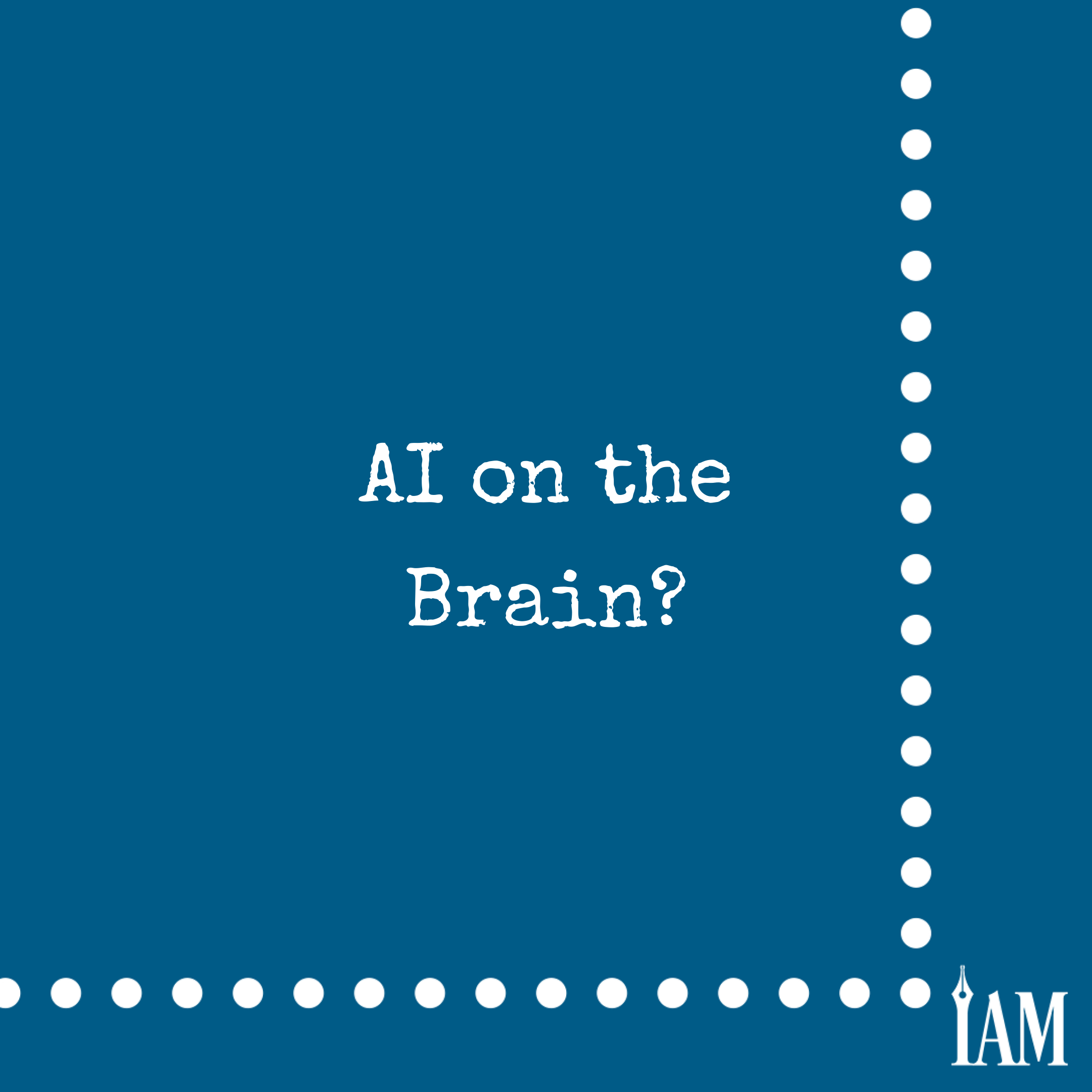
AI Perspectives for Indie Authors: Navigating the Story
At IAM, we have always prided ourselves on our ability to dissect and disseminate technology information for authors. From the beginning, we’ve understood the importance of having the right tools for your business and knowing how to use them. So it felt only right for us to dedicate an issue to breaking down the newest—and possibly most controversial—set of tools in our community.
As I started this letter, I thought initially about sharing my own ideas about artificial intelligence, but I realize now that writing them wouldn’t add anything meaningful to the conversation. Instead, I’ll share a saying I learned from one of my journalism professors that has gone through my head time and again as we’ve been crafting this issue: There are often more than two sides to every story.
We recognized early in reporting this issue that people’s opinions on AI are complex and varied, and we didn’t want to invalidate any of them with our reporting. Instead, we wanted to seek understanding, so we spoke to people from different corners of the publishing world about how they feel about AI and why, and we shared a poll on our social media channels that asked those same questions to the community at large. We wanted to provide you, our readers, with information that could help inform your opinions, so we created an extra fact-checking step in our production process to ensure our articles were as accurate and up-to-date as possible. We created a list of resources that we hope will provide even more accurate information about AI beyond our reporting here, because we recognize that the technology is progressing quickly, and aspects of our writing may not be relevant for long.
In essence, we tried to honor the various sides to the evolving story of AI as best we could—while still correcting misunderstanding and misinformation. We work in the book business, after all. Understanding stories, and telling them well, is kind of our thing.
Nicole Schroeder
Editor in Chief
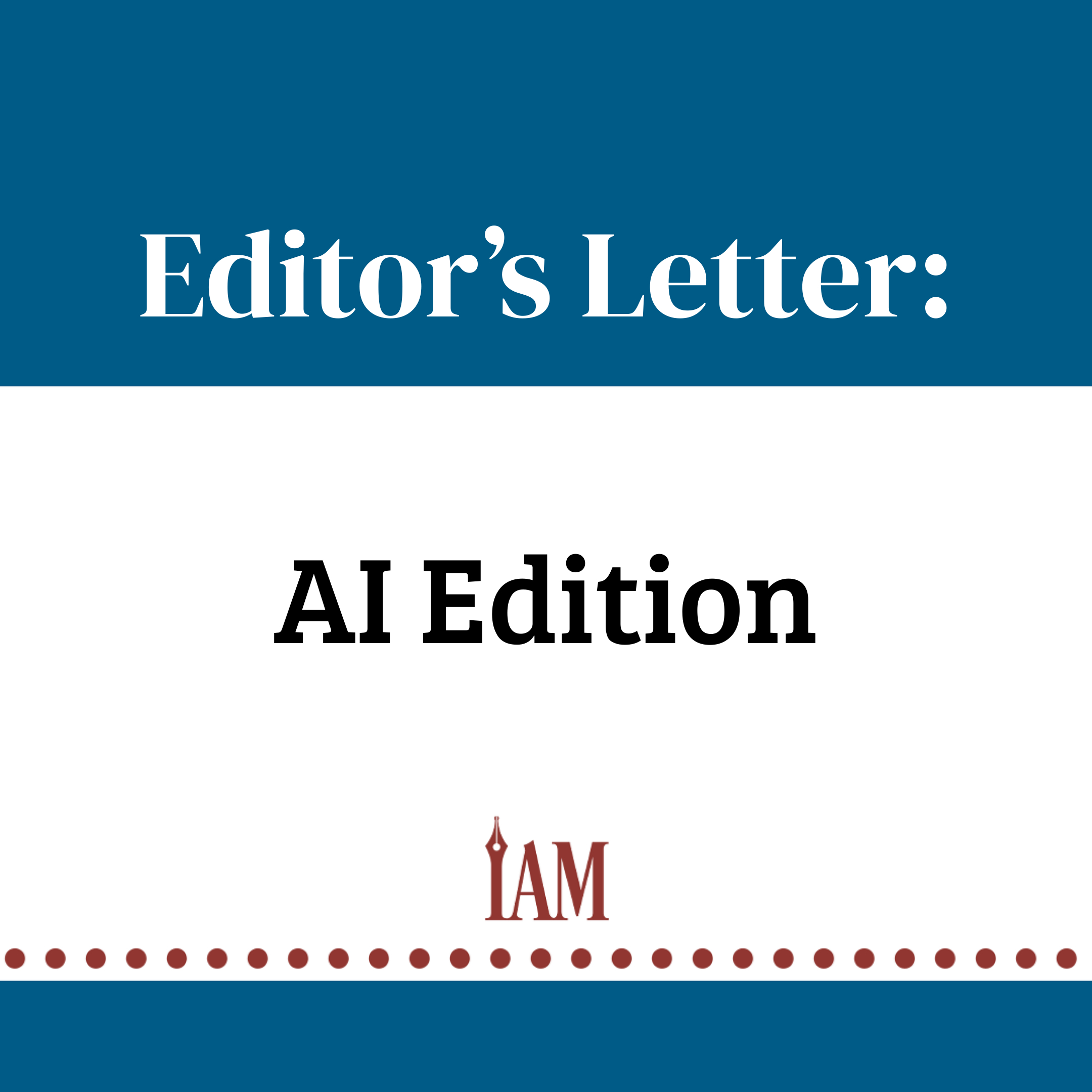
AI in Writing: Navigating Legal Risks for Authors
I’m not a fan of this topic because it’s a heavy quagmire of technical lingo while also crossing over the legal threshold and getting the lawsuit treatment, which means fitting those square techno-pegs into round legal holes.
We’ll see how the lawsuits pan out, but the takeaway will give the AI producers better guidelines. And AI will move forward. Does the technology generate new material or a ripoff of copyrighted material? That’s what the lawsuits will determine. Is the artwork AI creates sufficiently transformative, or is it simply derivative? Transformative is a legal use whereas derivative is a copyright violation. Who knows the right answer?
In the end, it’ll sufficiently evolve. Will we be able to work it into our own efforts, or will we fight it tooth and nail to the bitter end? It is coming. The best thing you can do is hone your craft and improve your storytelling to where no one else is doing what you’re doing at the level you’re doing it.
Surrender? No, but grow with the times. It is 2023, after all. We were already supposed to have died five times over from global cooling, global warming, the H-bomb, pestilence, World War III, drought, overpopulation … so many ways we were supposed to be wiped from the face of the planet. But we’re still here, and so is AI.
At some point in time, I’ll play with it. Right now, I’m not touching it. I’ll wait until the lawsuits are resolved, so I don’t have to redo or unlearn something. It’s hard enough to write the book the first time, let alone do it over. I have too many books to write to be walking backward.
AI. It is the future. Will it replace humans? I sure as heck hope so, but in the realm of physical labor, cleaning, and those things that take us away from our more cerebral endeavors. Exercise the mind, and do great things.
Some people will use AI to generate a great deal of new content in very short order. Can’t do anything about that except build a readership based on your work right now. They’ll keep coming back to you because they like the books you write. There’s also world-building. Build the intellectual property within which you can use AI to generate stories—you and no one else. To the IP owners, the spoils. Spice is life!
Be the recipient of derivative revenue. Sit back on a beach and retire. That’s just one outcome. There are plenty of other alternative timelines. Start writing yours today.
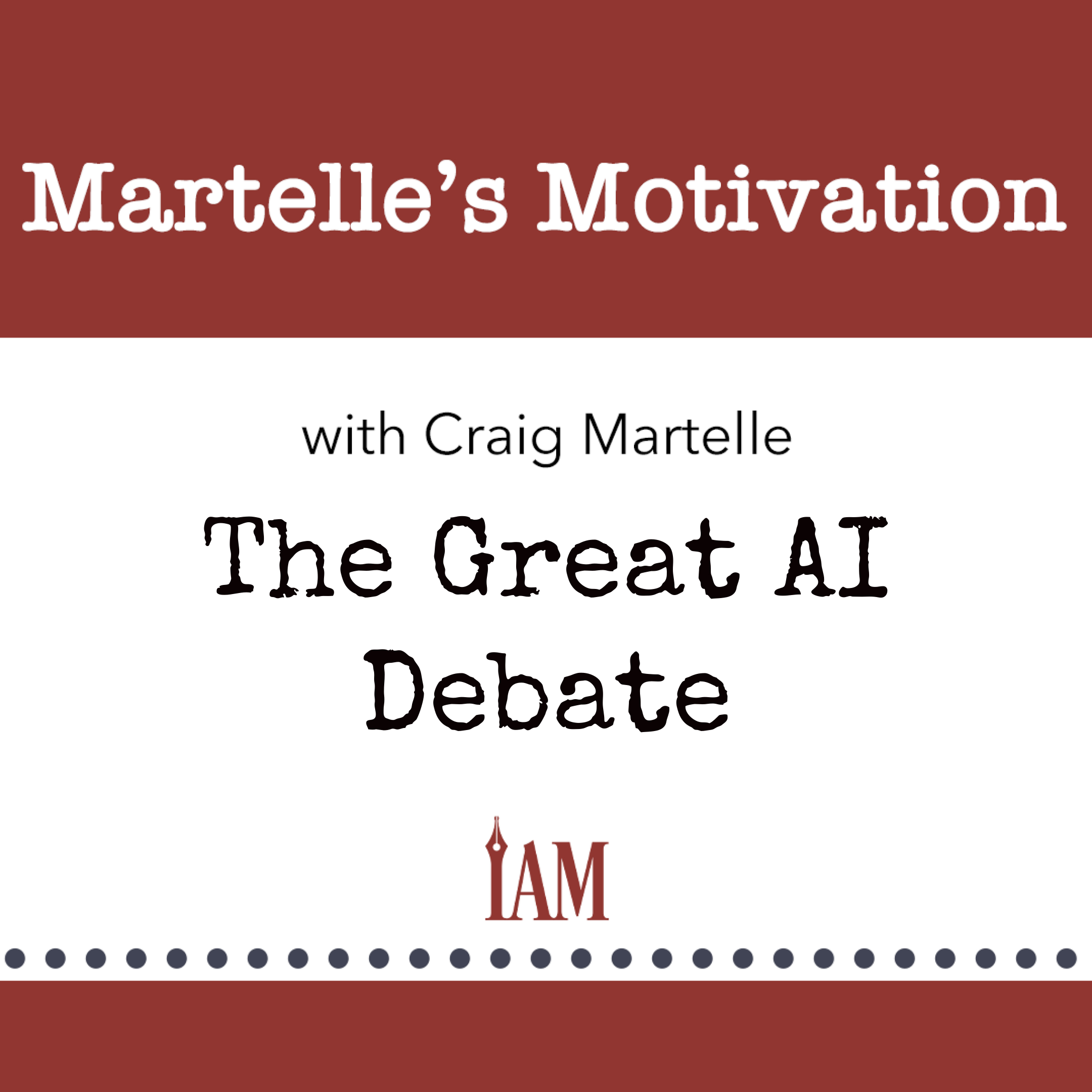
AI Copyright Challenges for Indie Authors
Guest Author Ash Roberts Explains Where the Law Stands—for Now
People tend to view copyright of AI-generated material as a settled issue, but that isn’t quite true. When it comes to AI, the legal case—or, more accurately, cases—for copyright is still a highly contested issue.
In the US, copyright happens in two phases. The second you create something, it’s copyrighted. But to enforce that copyright in court, you then have to register it with the US Copyright Office, or USCO (https://copyright.gov/). In most cases that independent authors will encounter, a Digital Millennium Copyright Act, or DMCA, notice is enough to stop copyright infringement. It’s only for lawsuits that registration is required.
Some are concerned about Amazon demanding proof of rights on AI-generated material, but right to use and owning copyright are two different things. We already publish things we don’t have the copyright to. To start, titles aren’t copyrightable, being a “short phrase” which others may have an appropriate need to. You likely don’t own the copyright to your cover either. Typography, background, model—the creators for each disparate part own their respective copyrights, unless those rights are explicitly transferred to you. In almost all cases, what you receive is a license to use it.
The only copyright you, as an author, own is the unique combination of words that make up your story. But you can only copyright material that has “human authorship, with the computer merely being an assisting instrument,” according to Section 313.2 of the Compendium of US Copyright Practices published by the USCO.
The question then becomes to what degree an AI produces its output without human intervention. There hasn’t been much discussion about the amount of prompting and iteration required to get a quality result. Jason Allen, who won an award at the Colorado State Fair with his AI-generated art, claims that he spent eighty hours and nine hundred iterations and evolutions across multiple platforms to create his piece, according to the Washington Post.
The USCO seems willing to acknowledge copyright when the AI output was changed by a human. When reviewing, and ultimately revoking, the copyright for Kristen Kashtanova’s comic, Kahyra of the Dawn, they asked her for details “to show that there was substantial human involvement in the process of creation.” Ultimately, they decided she hadn’t done enough to change the images Midjourney created, although they kept her copyright for the text, which she had written herself.
Two US Senators have asked the USCO to revisit the issue in context of the “monkey selfie” case, in which a crested macaque, Naruto, took photos of himself with a photographer’s camera, which the photographer later published in his book. In 2015, People for the Ethical Treatment of Animals (PETA) sued the photographer for violating Naruto’s rights under the Copyright Act, an argument that was overruled in district court and later dismissed in the 9th Circuit Court in 2018 after PETA appealed the decision. Judges in both courts ruled Congress had not specifically extended copyright law to animals, meaning the monkey held no ownership over the photos he’d taken, as PETA claimed.
Other countries confer copyright of AI-generated material to the programmer. That said, always check the terms of service of the program you’re using. Most will state that they don’t hold ownership over your material and will transfer those rights to you.
Meanwhile, Stephen Thaler, who created his own AI, is suing for copyright of the artwork it generates, claiming the “fruit of the tree” doctrine—that if he owned a fruit tree, he’d own the fruit it produced, the standard that many other countries currently use for AI copyright. Additionally, he argues that, contrary to Naruto, the Supreme Court has ruled when technology makes copyright law ambiguous, it should be interpreted in terms of whether public good is strengthened or weakened.
The copyright status of AI generated material may change soon, but for now the standard requirement for owning copyright in the US is “substantial human intervention”—something to keep in mind the next time you turn to AI for any work you want to label as your own.
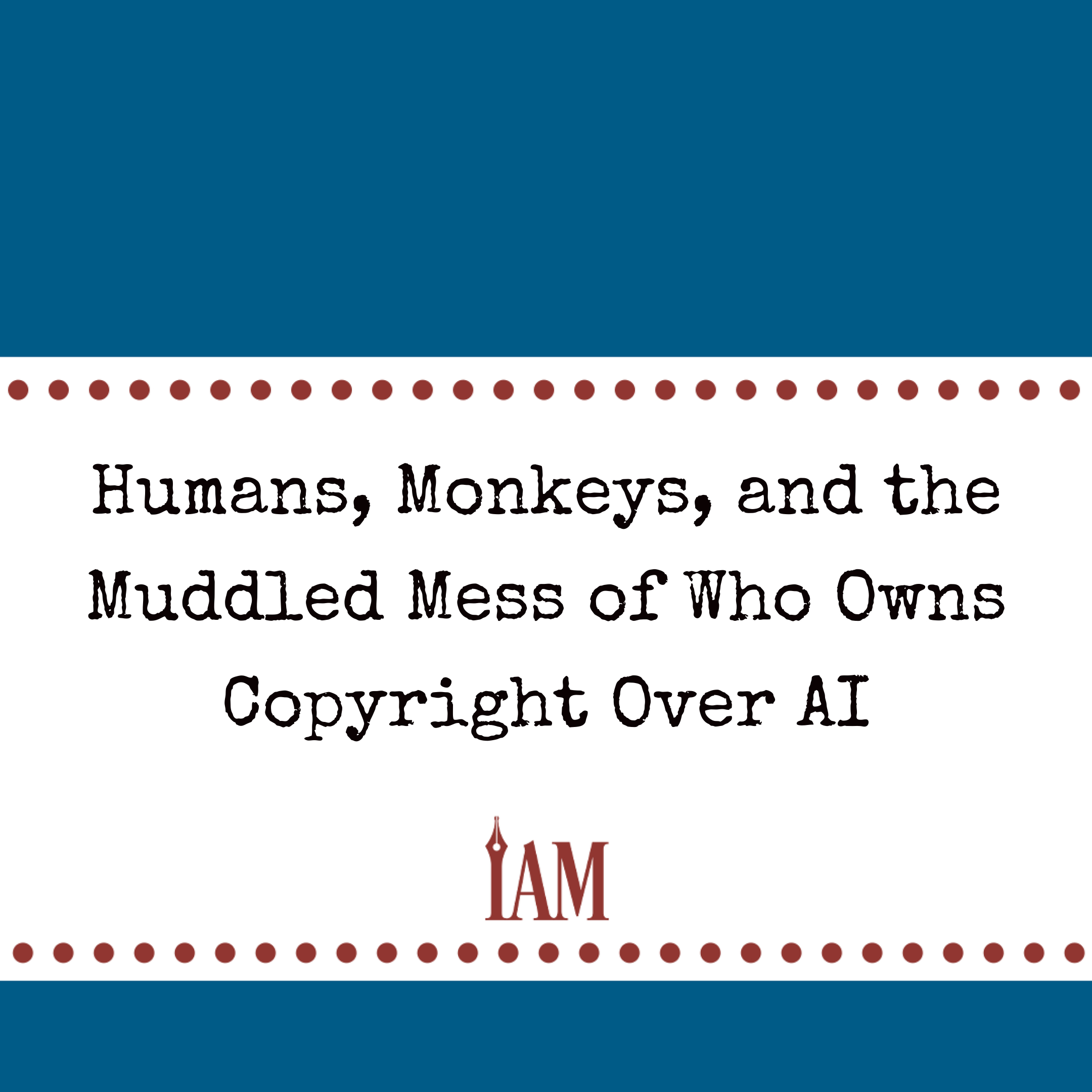
AI for Authors: Evolving Writing Business Models
As a self-proclaimed geek-in-heels, technology has been a mainstay in my life and career for over three decades. Since my first job out of travel agent training school in 1987, I was the office nerd, the one who could fix the printer or reboot the network. The agents I worked with were "old school," knowledgeable about the best restaurant in any country and how to get the hottest Broadway tickets, but they resisted even the most basic tech tools, like email.
Retail travel agencies had to evolve quickly with the introduction of the internet. I built my first website in 1995, heavily pregnant with my second daughter, and convinced my then-boss that this new thing called the world wide web would revolutionize our business.
Fast forward to today, and the traditional idea of the travel agent is all but dead. In its place are evolved travel professionals who command higher wages for their expertise and understanding of how to employ technology to serve their customers.
I see parallels between the mainstream use of AI in our industry and the evolution of the travel agent. If authors can adapt to the reality that AI is already changing the world, they will have the best shot at career longevity. AI can be used to outsource busy work, marketing tasks, and even help draft novels, write outlines, or create imagery.
Are there problematic issues around the legal and ethical ramifications? Absolutely. In this special issue of Indie Author Magazine, we aim to present a balanced journalistic perspective and provide resources and tools to monitor them. As a magazine, we neither advocate for nor against the use of AI.
As a technologist, however, this feels very familiar, and I hope we can bring some levity to the hotly discussed issues and shine a light on a hopeful path for our creative colleagues.
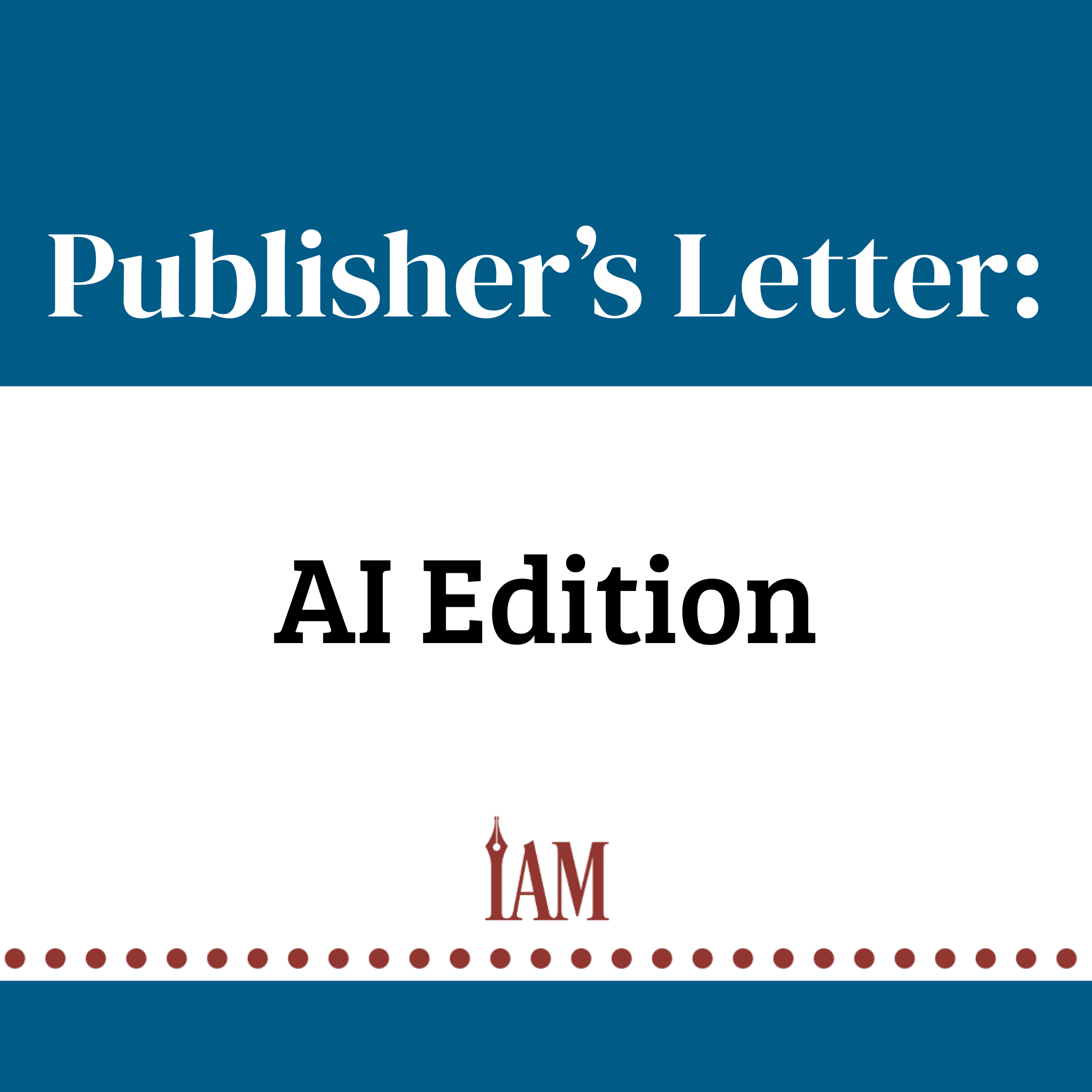
Facebook Ads Success for Indie Authors
Facebook’s advertising platform is, I would argue, the easiest ads platform to learn and the easiest to scale. You can spend a small amount of money and start selling books on the same day.
If you get it right.
Alternatively, you can hand your money over to Facebook in exchange for nothing. We want to avoid that. I won’t take you through creating a campaign on the platform; there are a dozen books out there that will guide you through it all in finite detail. Instead, we are going to focus on how to make ads that sell books.
The first point I want to put across is that Facebook is not trying to sell your book. It is finding people to click on your ad within the audience parameters you set. That is the end of its responsibility.
But you want people on Facebook to click on your ad, right? Wrong. You want people to click the call-to-action button, leave Facebook, and head over to your product page on whichever store you’ve selected. This is called an outbound click. Once a potential buyer lands on your product page, it is down to you to have that sorted with a hooky blurb and a devastatingly brilliant cover, so they have no choice other than to buy your book. None of that comes down to Facebook; they are just finding people who will click the ad and spend your assigned budget.
I will look at product pages another time. For now, we will assume you have all that set up perfectly. So how do you avoid wasting your Facebook advertising budget?
There are several factors in getting your ads right, two of which I place far above any others:
Image, and
Audience.
The purpose of your image is to stop people scrolling through their Facebook feed—but in order to achieve that, you must aim it at the right people. This is where your audience comes in. Look at the example below, which gives the advertising parameters for a Cozy Mystery audience.
Age:
50-65+
Gender:
Female
Language:
English (UK) or English (US)
Exclude:
Interests: Kobo eReader or Barnes & Noble Nook
People who match:
Interests: Brenda Novak, Elin Hilderbrand, Jill Shalvis, Lori Foster, Julie Kenner, Janet Evanovich, Debbie Macomber, Robyn Carr, Susan Mallery, Agatha Christie, Sophie Kinsella or Liane Moriarty
And must also match:
Interests: Agatha Raisin, Hallmark Channel, Midsomer Murders or Murder, She Wrote
And must also match:
Interests: Mystery fiction, Women's fiction, Crime fiction, Cozy mystery or Detective fiction
What you see here is a three-layer audience that overlaps authors with TV shows and genres. If you cast your mind all the way back to school—it’s a long way for me—you may remember what a Venn diagram looks like.
The audience in the above example aims only at the people who meet all three criteria. They must like at least one thing in each layer to land in the central bit of the Venn diagram. In this case, you’re targeting your ad at people who are hardcore followers of the Cozy Mystery genre or related interests.
Of course, you could just target those with “Cozy Mystery” interests and leave it at that. However, like all genres, there are many flavors hidden within. If you were to target only “Urban Fantasy” readers, you would capture all those who like the erotic or romantic elements of that genre. Chances are they don’t want your tough-guy action romp.
Tricky, isn’t it?
Of course, one alternative to building a targeted audience is to aim wide and let the clever Facebook algorithms sort it out.
The audience in this example is one hundred million people. That’s a big audience. Surely if you aim it that wide, your ad stands no chance of finding the right people who might buy your book, right? Ah, well, there’s a trick to making sure your ads find the right people. I will cover that when I write about images.
So when should you use each of these examples? Or should you aim for a different audience, perhaps one targeting a single author like Lee Child or Terry Pratchett? The unfortunate answer is that only experimentation will determine the answer for you. One solution will not suit all. However, I am yet to meet an author who could not sell their books with well-aimed, professional Facebook ads.
I could fill this entire magazine just talking about audience targeting, but I must wrap this up for now by saying you will need to experiment to find audiences that work for you.
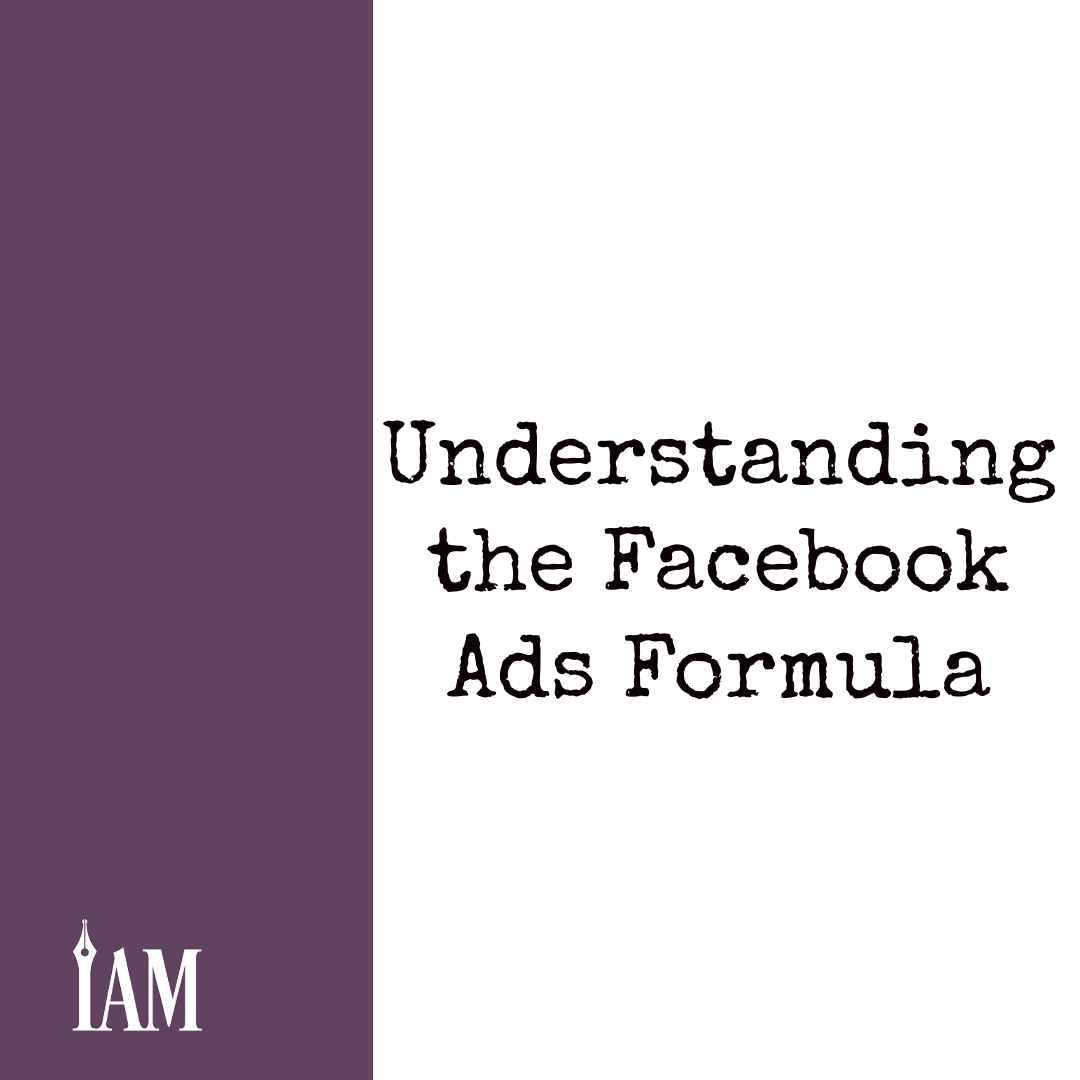
Understanding AI's Impact on Indie Authors
‘Artificial Intelligence’ Sounds Straight Out of Sci-Fi. But What Can It Really Do?
The robots are coming for your keyboards and your wallets. At least, that’s how the news may make it sound. In recent months, technological advancements in artificial intelligence (AI) programs have left every industry questioning what the future holds. The discussion is packed with mixed opinions, and the conversation has been particularly divisive in creative fields. Will AI run authors and artists out of business? Or perhaps authors and creatives will adapt, move on, pivot. Whatever your stance on the discussion is, we’d like to give you the quick and dirty on AI so you can broach the subject with an open mind.
Or not—the robots would love that.
Encyclopedia Britannica defines artificial intelligence as “the ability of a computer … to do tasks that are usually done by humans because they require human intelligence and discernment.” On this alone, you might be fearful that AI will write books with the click of a button. We’ll discuss the truth behind this idea later on, but for now, we need context to AI’s conception and where it stands now.
The Past
One of the oldest mentions of AI was by British logician Alan Mathison Turing around 1935, who theorized a machine capable of taking in data, storing it, analyzing it, and then outputting further data. Now, cell phones use AI and facial recognition software to enter the device, keyboards read thumbprints to verify your identity, and software checks your manuscript for common spelling errors. A 2017 study by Pegasystems Inc. found that even though only 34 percent of respondents realized it, 84 percent of people had used AI technology in the past—a number that’s likely shifted as the technology has become more integrated. AI has been around for a long time, and if you had the tech to search for this issue and purchase it online or read it on your device, you’ve probably used it.
Where AI steals the limelight is in recent developments, from Tesla’s self-driving cars to Sudowrite’s AI-assisted writing software, the influx of text-to-speech services capable of reading off audiobooks with human likeness, and the controversial chatbot ChatGPT.
ChatGPT, launched in 2020, replied the following when prompted: “I am a large language model created by OpenAI. I am designed to understand and generate natural language responses to a wide variety of questions and prompts. My purpose is to assist and provide helpful responses to users who interact with me.”
These generative programs are the areas that have some in the publishing industry especially concerned—both because of the content they produce and because of how companies collect the information they use to make decisions.
The Present
AI, by design, requires an input of information. As such, how AI sources information has become a talking point in the ethics of AI-generated content.
Sudowrite states in its FAQ that “the AI [used by the program] works by guessing one word at a time, based on general concepts it has learned from billions of samples of text.”
When prompted, ChatGPT states something similar. “My knowledge is not based on personal experience, but rather on patterns and relationships that I have learned from the vast amounts of text data I was trained on,” according to the program.
Stable Diffusion, an image-generating program and AI model, states on its website that the program was trained on a dataset collected from a general crawl of the internet.
The commonality among these three services is the data sources used to “train” the AI. AI cannot, by Turing’s definition, create without input. For many of the more popular AI programs of today, including ChatGPT, those sources are expansive datasets “scraped” from publicly available information on the internet, often a few years old. The programs typically do not collect personal data or have access to the internet to search for information in real time. On the other end of the system, prompts have to be crafted and initiated by a user, meaning misuse or abuse of the programs’ generative abilities, such as in using it to generate copyrighted materials, typically result from the user and not the technology on its own.
Since the information used to create images and texts is not unique, the ethics of such creations are at the forefront of the conversation. Whose information are these AI platforms using? Do individuals need to grant express permission for AI “scrapers” to access their data for use? Finally, once the AI does generate something, who owns the output?
These questions are part of a larger ethical and legal debate that will probably, like AI development itself, be a fluid situation. The latest model of ChatGPT, launched March 14, can output approximately six thousand words currently, and a second version of the model, currently available to select developers, can generate close to twenty-five thousand words at a time. Sudowrite can do the same but markets itself as a creative assistant rather than a chat prompt. So who owns the rights to the content AI produces?
According to US courts, AI-generated content cannot be copyrighted without an element of human alteration, the same as with public domain images. However, the specific rights and licensing terms a user has to their generated content may vary across programs. The AI art generator Midjourney, for example, grants users different rights depending on whether they have a free or paid account with the program.
The Future?
AI has a lot of capabilities, and ethically, we’ve extended an olive branch to certain functions we’ve decided we’re comfortable with. ProWritingAid and Grammarly both use AI to help edit your manuscript. Microsoft Word uses AI to do the same. Amazon uses its own AI to predict your search results. We’ve written these functions off as OK; the main points of contention today are around generative AI programs.
This is where creatives must decide for themselves how much of their work they will “outsource” to AI and how much is a labor of love, par for the course, or some other cliché AI should be screaming at us to fix.
Some authors are already using generative AI programs in their businesses. Joanna Penn, in early February, described on her blog how she utilized ProWritingAid, Sudowrite, and ChatGPT in drafting a recent short story. Before that, in August 2022, Derek Murphy, of Creativindie, outlined how authors and designers can use Midjourney to create a book cover image.
There have been instances at the other end of the spectrum in which AI was used to fully generate short stories.
Earlier this year, Clarkesworld, a Sci-Fi literary magazine, had to shut down submissions because of the number of AI-generated short stories it received, with the editor noting the stories could be replicated to some degree with the right prompts. The editor and her team could detect the AI-generated stories, observing similarities between the stories and calling them “inelegant.” Though detectable, the sheer volume of AI-generated stories resulted in the submission pause.
It should be noted, however, that AI doesn’t need to be used to craft a final product. Just as ProWritingAid and Grammarly are used as tools in the creative process, many authors, like Murphy and Penn, have used AI generative programs to assist in various stages of publication, providing direction, generating ideas, or adding speed to their process.
The conversation surrounding AI-generated content remains current, with some embracing the programs as tools to make their work easier and others using them to circumnavigate various stages of the writing process that used to absorb large quantities of time, such as editing. Alternatively, some view AI as a threat to creatives or consider the programs an ethical dilemma to avoid. Wherever you line up, AI is undoubtedly raising questions and making its presence known in the author community. Only time will be able to answer the question of how it will evolve from here.
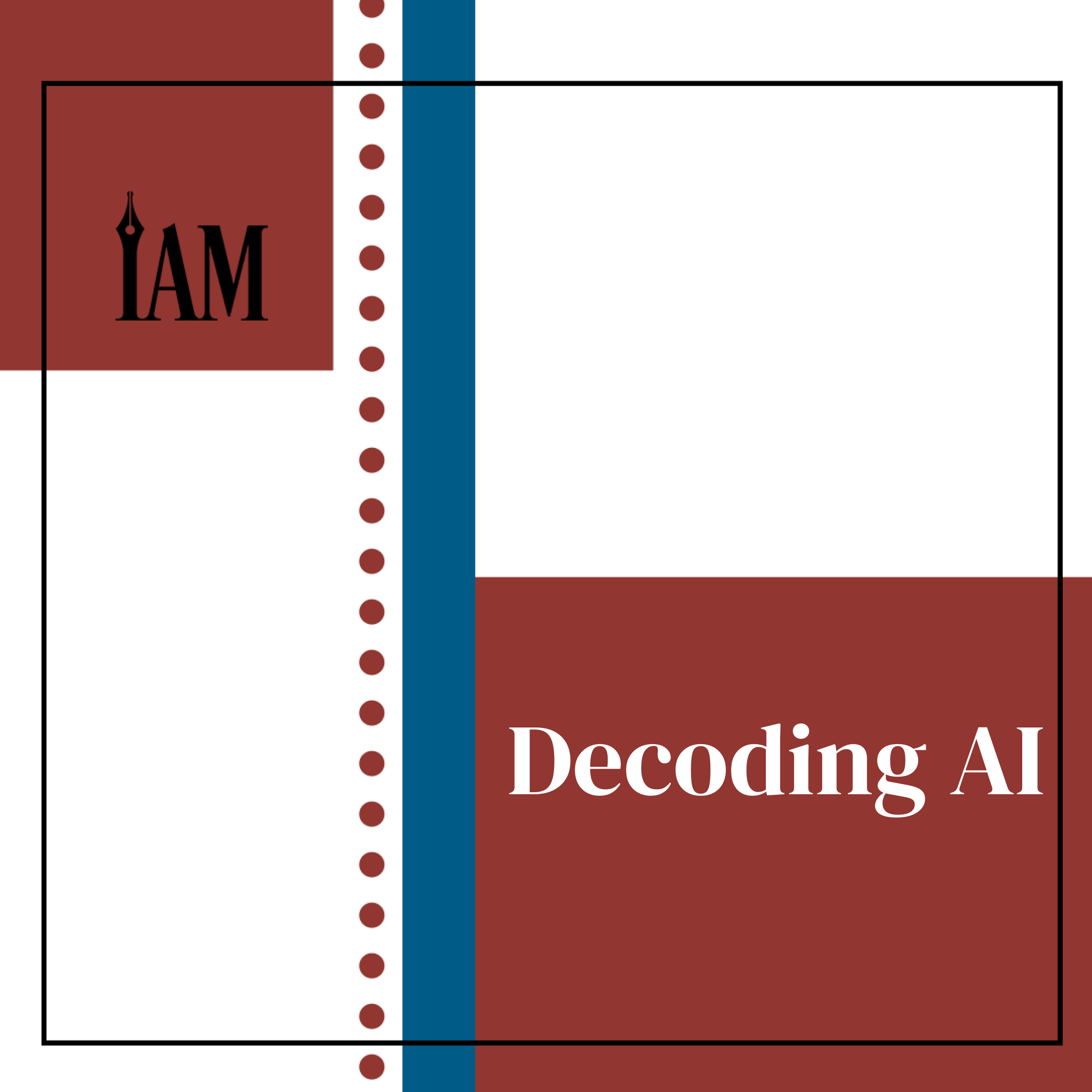
AI Marketing Strategies for Indie Authors
What You Should Know about AI as a Marketing Tool
Alexa. Google. Bixby. Siri. The automated voice that directs you when you call a business. Artificial intelligence (AI) is everywhere, and it’s growing. Can it help indie authors market their work? Absolutely! Are there some caveats? Absolutely.
Despite some authors’ hesitations regarding AI use in the creative aspects of their businesses, current programs offer several practical applications for producing promotional material as well. Elizabeth Ann West, Historical Fiction author and communication and education lead for Sudowrite, describes Sudowrite as a “junior writing partner”—the ultimate assistant for an author who is stuck. The application helps with brainstorming, outlining, drafting, and rewriting, and though my hope for an ads-creating-and-managing robot might not exist just yet, there are plenty of other applications for AI in marketing as well.
For example, “Sudowrite has a Tweetstorm feature that can turn any prose into a series of social media posts,” West says. “Other AI tools are building the exact tools you're asking for [ads robot], such as target audience and demographics and even crafting marketing copy and creatives for various audiences. Imagine a marketing world where you don't have to spend money to see if the ad will work; you already have a good idea from the ‘AI readers’ it was tested on.”
Sudowrite isn’t the only AI program with features like those West describes. Jasper.ai promises to “generate months of social media content in minutes,” according to its website. Plus, Jasper can read and write in twenty-six languages, helping you to advertise your books in international markets. Like Sudowrite, Jasper helps brainstorm and is designed to improve your writing, as well as create marketing copy that can translate to sales. Although the application wasn’t designed specifically for authors, the application includes more than fifty built-in templates that could benefit authors, such as content improvement, Facebook Ads copy, marketing angles, and video topic ideas for those marketing on Instagram and TikTok.
Turning a chapter or a scene from your current release into a series of social media posts would be beneficial and time-saving, allowing indie authors to concentrate more on their writing. Help with those dreaded synopses and/or back-cover blurbs would also be wonderful. The social media scheduling platform SocialBee recently rolled out an AI Post Editor Assistant—in beta, at the time of writing—that may be able to do both. According to SocialBee, the application will write and edit social media captions and can summarize blog posts from a URL you provide.
Although it may not be the ads robot of my dreams, Wix has also rolled out an AI application called Facebook Ads by Wix, which uses “advanced computing to analyze data and better understand one’s target customers.” The application doesn’t target authors specifically, but Wix indicates on its blog that the technology is designed to help small businesses “identify the platforms, placements, locations, and audiences your advertising will have the greatest impact on.”
AI has also entered the realm of book market research. "We have been using machine learning in our business for some time," reports Alex Newton, founder of K-lytics.com, a leading market research service for authors and publishers. "We all know that more often than not, the search results and bestseller lists that Amazon presents include books that have little or nothing to do with the genre or type of books you are looking for. Therefore, we started constructing our own Virtual Bestseller Lists in our genre research.”
For example, Newton advises that if a book title or blurb includes the terms "mate," "scorching hot," "blue eyes," "his strong arms," or any other of a growing list of what he calls genre clues, chances are high that the title in question is a Romance. Imagine you run a combination of genre lists and specific filtering criteria against hundreds of thousands of books. At K-lytics, the trick is to have a large quantity of book classification results generated automatically but reviewed manually, i.e., by a human.
“Thus far, AI still cannot beat human judgment,” Newton says. “We had ChatGPT classify a long list of books, but it fell short for at least 15 percent of books."
Marlowe is an application designed for authors by authors. Founded by Matthew Jockers, Alessandra Torre, and J.D. Lasica, Marlowe reads your manuscript and gives you an in-depth report analyzing the plot structure of your novel, your narrative beats, your story’s pacing, your characters’ personality traits, and a comparison of dialogue to narrative writing. Marlowe also flags possible cliches and repetitive phrases, as well as adverb and adjective use. Not only does the application give authors this information, but it also suggests how the data might be helpful to them.
Author and marketing coach Nicholas Erik writes, “AI … can do a lot of stuff better than the current options we have. If I want to write 50 taglines, that would probably take me an hour. Whereas ChatGPT can do that in under a minute. Even if 45 of them are garbage, it's massively more efficient than what I can accomplish on my own. By using AI as a tool, we can come up with turns of phrase, plot points, marketing copy, ad angles, creatives, and other things that would have otherwise never have crossed our minds. Thus allowing us to increase the level of our marketing and writing craft at a truly breakneck pace.” Erik explains that he doesn’t think authors will be replaced but instead “augmented” by AI, so long as they can adapt to the tools effectively.
Writer Beware
Of course, AI programs like these also pose ethical concerns in some circles that may counteract the help they can provide. ChatGPT is one of the more popular AI apps that has received a lot of attention lately, and not always for good reason. Released on November 30, 2022, by OpenAI, ChatGPT can act as a virtual assistant for writers. I tested this theory myself in getting suggestions for taglines and back-cover blurbs for my work-in-progress as well as wording for a newsletter. I was pleased with the output and able to make a few tweaks and have the work done much quicker than I normally would have.
I was surprised, however, when my protagonist’s surname was generated in one of the back-cover blurbs when I’d only told ChatGPT the character’s first name and the name of the series. I asked the chatbot how it knew my protagonist’s last name, and it basically responded that it was a coincidence. I wasn’t so sure.
On its website, Authors Guild reports that the organization “has been actively engaged in legal and policy discussions surrounding AI and copyright.” Because of concerns about data mining for use in training AI models, Authors Guild has also updated its Model Trade Book Contract and its Literary Translation Model Contract to include additional clauses that prohibit publishers from using or sub-licensing books under contract for this purpose.
Many independent creatives, such as authors, audiobook narrators, illustrators, and editors, are concerned with being replaced by AI technology. However, though AI audiobook narration is getting better all the time, many others argue against its ability to replace a voice actor breathing life into an author’s characters. Still, is there a place for both in the industry?
When I asked West about the issue, she said, “I think there's going to be some pain in the industry, but in the end, the AI-generated audio content and other content will … be a good thing. More readers of niche genres will have audiobooks that might not be a project any publisher or narrator could invest time and resources into producing. With more platforms like TikTok and YouTube becoming the place that readers and listeners consume content, AI-generated narration will allow a content creator, like a writer or other artist, to bring their projects to the audience without having to have a large bankroll to do so.”
West says the best way to market a book is to write another book, and many independent authors would likely agree with her sentiment. While AI can certainly help with writing that book, it’s the author’s responsibility to do so ethically and wisely. Still, if you’re like me and can use all the marketing help you can get, you might want to learn about the AI applications available—at the very least to assist you in reaching your target audience.

How AI Art Enhances Your Book Launch Strategy
Since its launch in 2022, Midjourney has been a game-changer for the internet's supply of adorable cat photos. AI-generated cat illustrations are almost everywhere. Tabbies sip catnip tea, wear designer clothes, and sport rainbow-colored fur.
However, few people realize how much artificial intelligence, or AI, programs—Midjourney specifically—have improved in just a few years, or the wide range of products authors can now create for their book launches using the program. If you combine Midjourney illustrations with other programs and apps like Canva, Vellum, Pixelmator Photo, and/or Adobe Photoshop to edit and format your images, you can create custom-designed book launch materials, from bookmarks to chapter headings to full-wrap dust jackets for your hardcover books. And while it can be difficult to find diverse characters or futuristic settings on stock photo sites, it’s no problem for an AI program to generate those images.
It just takes practice and a little help writing your prompts.
When it comes to your prompts, you’ll need to learn the correct ratios and descriptive keywords and even the proper use of punctuation, but this article will give you tips and a few sample prompts to get you started. As of March 17, Midjourney has just launched its fifth version of the program. According to Midjourney’s announcement to subscribers, the new V5 base model is currently in Alpha Test mode and is said to have “much wider stylistic range … higher image quality … more detailed images … improved performance, [and] improved dynamic range.” The prompts and images in this article have been tested in V4, but you can also try them in V5.
Note: The example images shown in this article have not been edited from Midjourney’s original output except to add text where applicable, but any necessary changes could be made in photo-editing programs after downloading the images from the AI.
1. Illustration Style
Before you begin, it’s a good idea to choose an illustration style. Think about the underlying themes and the genre of your book. If it’s moody and dark, then a black and white ink style might work well. But if your story is a light, hopeful fantasy, you’ll probably want a more colorful, painterly style. Play around with art styles and include those descriptive keywords in your prompts. However, please do not use actual artists’ names in your prompts. You don’t want to cross into morally or legally gray areas that may offend the artists in question.
Pro Tip: The below prompt works well in V5 and can be used in other ratios to gain experience using the program. In general, images need less touch-up in V5 and can be generated in 2:1 and 3:1 aspect ratios—abbreviated to “ar” in the example prompt—with success.
Sample prompt:
A mysterious island in the Puget Sound as a symbol in a YA illustration, tall elegant trees, mist, fairy lights, purple color palette --ar 2:3
2. Your Characters
You know your characters better than anyone, and with AI-powered design software, you can now bring those people—or aliens or animals—to life. You can then use the images you create throughout your book’s marketing campaign.
Size ratio is important. Begin by making your characters in either a 2:3 or a 9:16 format. Once you have about eight character illustrations, import them into Canva, a free online design program. There, you can design digital or print projects, like character postcards or bookmarks, to give to your readers.
Sample prompt:
Realistic woman is riding on a flying dragon, in a dark fantasy world, epic, fairy tale, magical realism, superhero fiction, sword and sorcery, book illustration, magical color palette --ar 2:3
3. Character Cards
The first project you can make with your illustrations is a set of character cards to be included in the front or back of your book or as a separate print for your fans to purchase. Once again, start with a 2:3 size ratio, then individually import each illustration into Canva. Consider giving each one a black background border, then download those final images. Next, create a two-page spread for your book in Canva, give it a background, and import and position those eight character cards.
Be careful not to place any illustrations across the center spread, or where your book’s spine will be, since those images might not line up during the printing process. Download your final two-page spread, drop it into your book formatting program—Vellum is excellent for this—and boom, you’re giving readers a first-hand glimpse of your characters when they purchase your books.
Pro Tip: You can also use your two-page character spread for digital promotions and print giveaways. Just remember to adjust the resolution to 300 dpi for all items you plan to print. If you’re working on a Macintosh computer, just open your image in Preview, go to Tools on the toolbar, select Adjust Size, change the resolution to 300 dpi, and save.
4. Bookmarks
The images you’ve created so far can be repurposed yet again as bookmarks advertising your books. These will be printed, so choose your printer and select a size for your bookmarks. Most have dimensions somewhere between 2 inches × 6 inches and 2 inches × 8 inches. Create a custom-size design in Canva in the proper size, and include the dimensions for a full-bleed if you want your printed image to extend beyond the bookmark’s edge. For simplicity and consistency, use the same background as your two-page character card spread. Next, import three of your character card images, and line them up vertically on your bookmark design.
Pro Tip: Put the name of your book and your website in small print at the bottom of your bookmark and you’ve created a one-sided promotional piece that you can get printed, sign the back, and send to your readers.
5. Interior Illustrations
Most likely, you’ll use your character illustrations for your book interior as well. Remember to increase the resolution to 300 dpi, since these will be printed. Touch up any imperfections in your images, using either Adobe Photoshop, Pixelmator Photo, or any other image-editing program you prefer, and size each one to fit a single page.
Pro Tip: If you use a print-on-demand printer like BookVault, you may be able to opt for a few or all of your illustrations to be printed in color inside your book.
6. Custom Chapter Headings
Custom-designed chapter headings can help to create a boutique book experience. For this project, you can choose to illustrate a setting from your book or one of your characters—or both, as you’ll need a foreground and a background for the final product. Remember, all the art inside your book and on your cover should coordinate, have similar colors, and be in a similar art style. It may take you several tries to get an illustration that works for this, but don’t give up.
If you’re working in Midjourney V4, generate your image with a 3:2 ratio; if you’re using V5, you can try 2:1 or 3:1. Once you get your image, import it into Vellum or a comparable formatting program. If using Vellum to create a custom chapter heading, go to the Styles section, choose a style, then click on the Configure Style icon. Once you’re inside the next section, click on Heading Background. Select the two-page Image Span and Full Bleed Image Extend. Once you do this, Vellum will let you know the exact dimensions your image needs to be—note that you may need to adjust the size of your image a bit. Other things that will need to be selected are in the Print Settings. Click on Text Adjustments and select Chapter Begin, right side. You can also select whether you want your images in color or in black and white.
Pro Tip: For this project, having a dark or misty background works to your advantage since your text will flow on top of it. If your background is dark, switch your book text to white.
Sample prompt:
Left, foreground: Realistic man riding a horse, in a dark fantasy world:: background: mists and mountains and a distant castle:: epic, fairy tale, magical realism, superhero fiction, sword and sorcery, book illustration, magical color palette --ar 3:2
7. Book Covers
For authors who want to truly test Midjourney’s mettle, consider using the program’s outputs to generate your book’s cover—or at least the images that you’ll combine to make it. If you want to create more than one book cover, consider combining your Midjourney illustrations with Canva. You could create one cover for a hardcover dust jacket, a different cover for the hardcover case laminate, and a third cover for the coordinating paperback.
Start with your template—which can be easily obtained from your printer—and import that template into Canva. Select two character or setting illustrations from your interior illustrations. Use one for the front cover and another one for the back. At this point, you may need some expert assistance in selecting and using fonts, in creating your spine text, and in placing and formatting sales information on your flaps.
Pro Tip: Midjourney’s V5 has some new size ratios—2:1 and 3:1—that work amazingly well for a dust jacket and can often cross the spine and even stretch to cover both side flaps.
As indie authors, most of us already know how to write, edit, format, and publish our books. However, with the new artificially intelligent art tools available to us, we now have the opportunity to create top-shelf, boutique-quality books for our readers on our own as well.
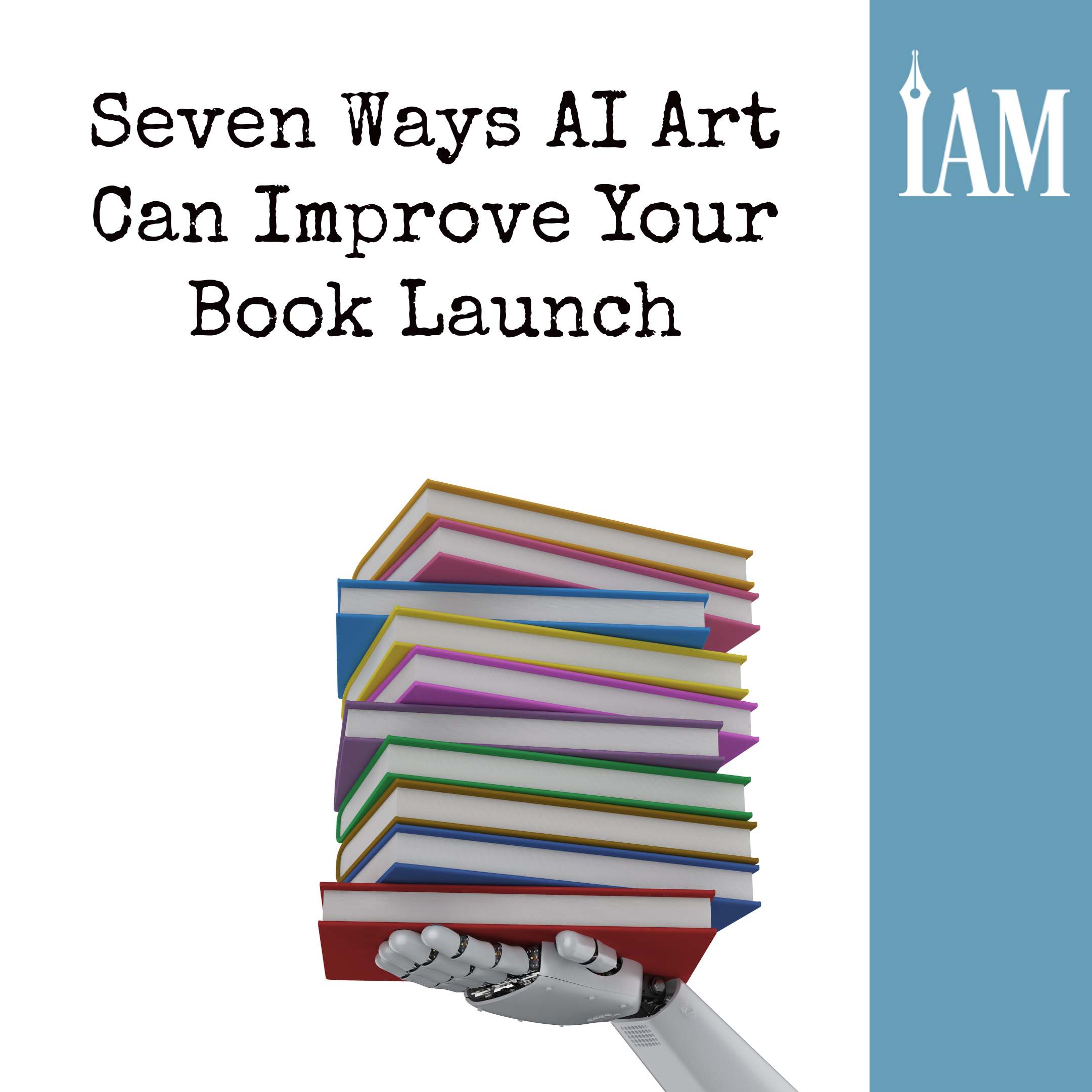
Navigating AI Ethically as an Indie Author
Dear Indie Annie,
If I’m being honest, AI concerns me. I worry about its impact on the publishing industry and that it is taking jobs away from creatives. I also worry about the potential for plagiarism with what it creates. But I don’t want to turn it down outright. Are there ways I can use these programs ethically as an author?
Apprehensive about AI
Dear Apprehensive,
That’s a long and not very positive first name. Do you mind if I call you Appy?
Sweetheart, no offense, but you’re not a very “appy” bunny now, are you?
I understand your concerns; I really do. I mean, who is to say that my gorgeous colleagues at IAM haven’t run this response through a creative writing app? Maybe these beautiful words are actually the soulless outpourings of an online robot. After all, I am an avatar.
Or perhaps I was uncharacteristically lost for words and popped your question into an AI program for inspiration. I assure you I did no such thing. But, sweet Appy, would it really matter if I had?
Wasn’t it Bobby McFerrin who sang “Don’t Worry, Be Happy”? Wise words, indeed. As Mr. McFerrin stated, “When you worry, you make it double.” I put it to you. Would a bot have such wisdom and insight?
Whilst these terrifying algorithm-munching cyborgs may, on command, produce a witty ditty or a stunning image here and there, they do it at our behest. They take their inspiration from the digital world around them, a world that thousands of years of human creativity and innovation forged. And if you are worried that, using this inspiration, they will one day replace us creatives? Maybe they will. None of us own a reliable crystal ball with which to tell the future, but looking at how these things have played out in the past, I doubt it.
As for concerns about copyright and plagiarism, has there ever been a time when we haven’t borrowed ideas from those around us? Did the first cave person to spit terracotta pigment around their hand on the inside of a mountain worry about their technique being copied or improved upon by the generations that followed?
Copyright and plagiarism are modern concepts developed as we commercialized our art. And trust me, my dear, darling Appy, I believe plagiarizing lowlifes should compensate us if they steal our work. A time of reflection behind bars could also be desirable, arguably. As with all issues around copyright, that is an argument best left to those trained in the legal profession. I am a sassy columnist and would never venture near giving any form of legal advice.
I am certain, in time, the protectionist laws we trust to ensure we receive a fair reward for our hard work will catch up with the developments in AI. In the meantime, what can you do to protect yourself as an artist or a writer? Do what you do already.
Ensure you assert your rights online. Have your copyright on your website, published book copy, images, etc. Use full disclaimers where you have used AI. Credit any artist who has worked with or for you, and insist they do the same. Be wary of who you share unpublished work with. I could go on, but IAM has advised me they have given this entire magazine over to the pros and cons of AI, so I am sure these processes and protocols are covered more expertly elsewhere.
As to using these tools ethically, if you are not one of those plagiarizing lowlifes I mentioned above, what are you worried about? Consider how much AI you already use in your writing and your day-to-day life. Though I have not run this baby through a creative writing bot, I have run it through spelling and grammar programs. I have a couple I use all the time and love to watch them battle it out. Sometimes they disagree with each other and then I, the human creator—indeed, the ultimate word wizard—decide whose suggestion is right and whose alternative is to be cast into the fiery pit of digital oblivion.
And once those perfectly curated words are ready to flee my nest, the lovely Nicole, our editor in chief, edits them again before they are published, after which an AI voice speaks for me for those amongst us who prefer to listen rather than read. Isn’t the world of AI wonderful?
All innovations can be threatening. Change and progress usually are. The Luddites in nineteenth-century England famously broke the machines in their local factories, but the industrial revolution still happened. Those who adapted survived. Remember, dear Appy, there was a time when stories were told orally until someone invented writing. The printing press revolutionized the accessibility of those written words. E-books gave us a quick, global route to an audience of avid readers. Some prefer audiobooks, but many still prefer to hold a physical copy in their hands.
What never changes is that we humans love a good story. Bundle up all your worries and woes, and direct them into something compelling. Construct a great tale, and AI won’t bother you.
Happy writing,
Indie Annie x
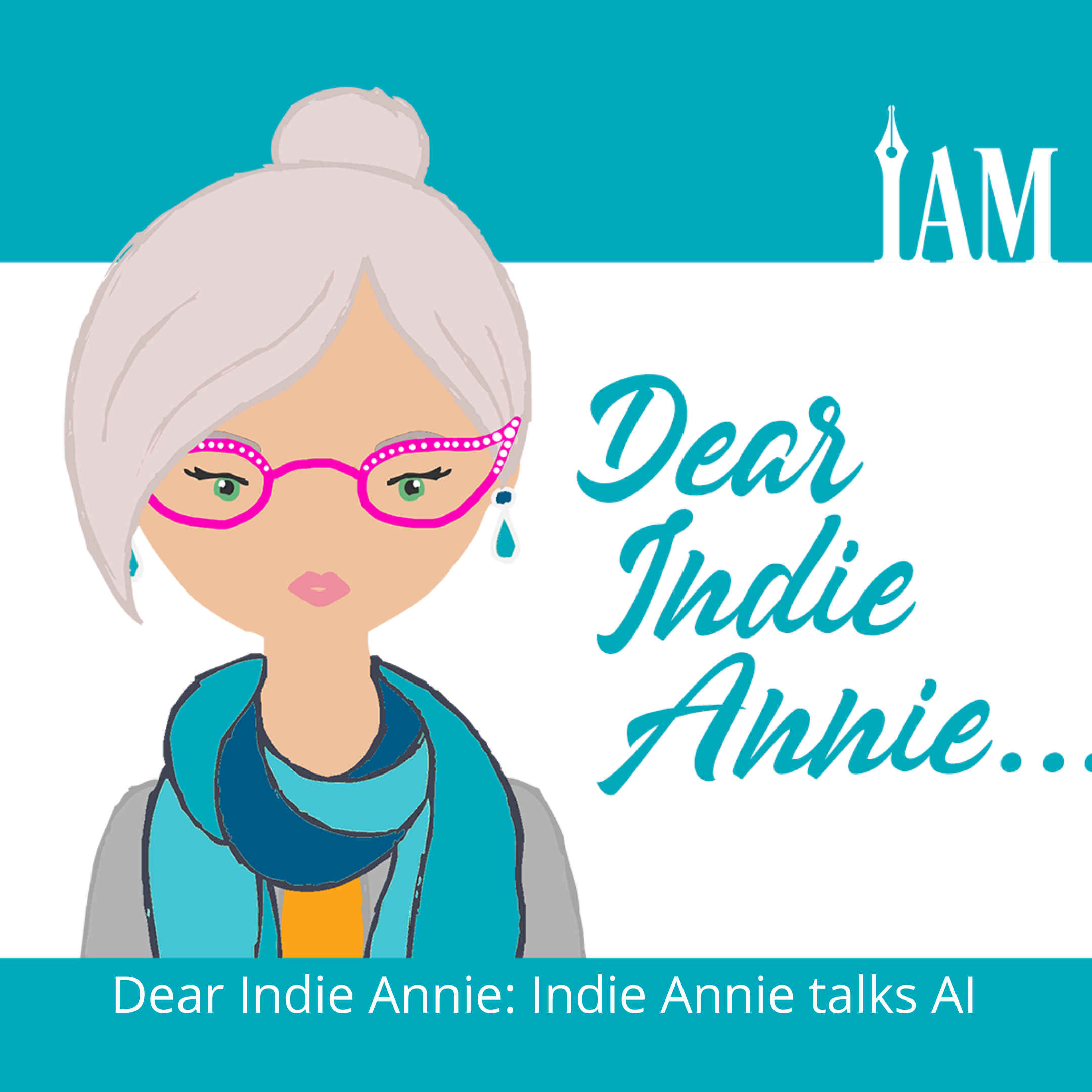
Master AI for Indie Author Success
Does it seem to you like everyone, or almost everyone, is freaking out as AI and ChatGPT gain recognition and popularity?
Are you someone who thinks that these two could be taking cash money right out of your pocket?
I’m not. I encourage you to, in the words of Taylor Swift, calm down. And here’s why.
As much as these computer programs can make our lives (and writing!) easier, nothing truly replaces good old-fashioned humans. We are the OGs, and we are here to stay.
Although computers can be given direction, be directed by an algorithm, and output results startlingly fast, nothing is crazier than fiction, and nothing is better than you—a human.
Said another way, only you can create magic by bringing two great ideas together. (Chocolate plus peanut butter equals magic! Popcorn plus a great movie equals bliss!) Computers can’t do that because they can’t think.
Truth is crazier than fiction, and your brain is more creative than the most sophisticated AI.
Would it also be helpful for me to remind you that every moment you focus on what you might lose through the advent of AI is a moment you’re not spending time quietly thinking up your next writing project, or actually writing it?
You can’t face north and south at the same time. You can’t be positive and negative at the same time. You can’t figure out how to maximize your prosperity if you’re focusing on your potential poverty.
Case in point: While someone is on Facebook right now lamenting the fact that “AI is replacing writers!” and “ChatGPT is the end of creativity as we know it!” I’m sitting here writing.
Human touch, just like human creativity, is ultimately irreplaceable, which means you can continue to do what you’ve been doing: making great art, writing your words, and being awesome and creative.
Plus.
You can utilize AI to your advantage. I’ve only used it once: to generate a webinar title. I didn’t think most of the titles, save one, were all that great. I ended up not using any of them, but the one I kind of liked gave me a jumping-off point.
Here are a few suggestions for how you can use AI to jump-start your prosperity:
Use it as a jump start for your writing—kind of like having a template as opposed to a blank screen.
Money likes speed. So does creativity. Use it to create your words faster and easier.
Amplify your ideas by using AI, and then put your brain on them to make them better, as only you can.
I’ve always thought of technology as tools to make my life better. Just keep asking yourself how AI can make your life, and your writing, better. Your brain will deliver answers to the questions you ask it.
Happy and prosperous writing!
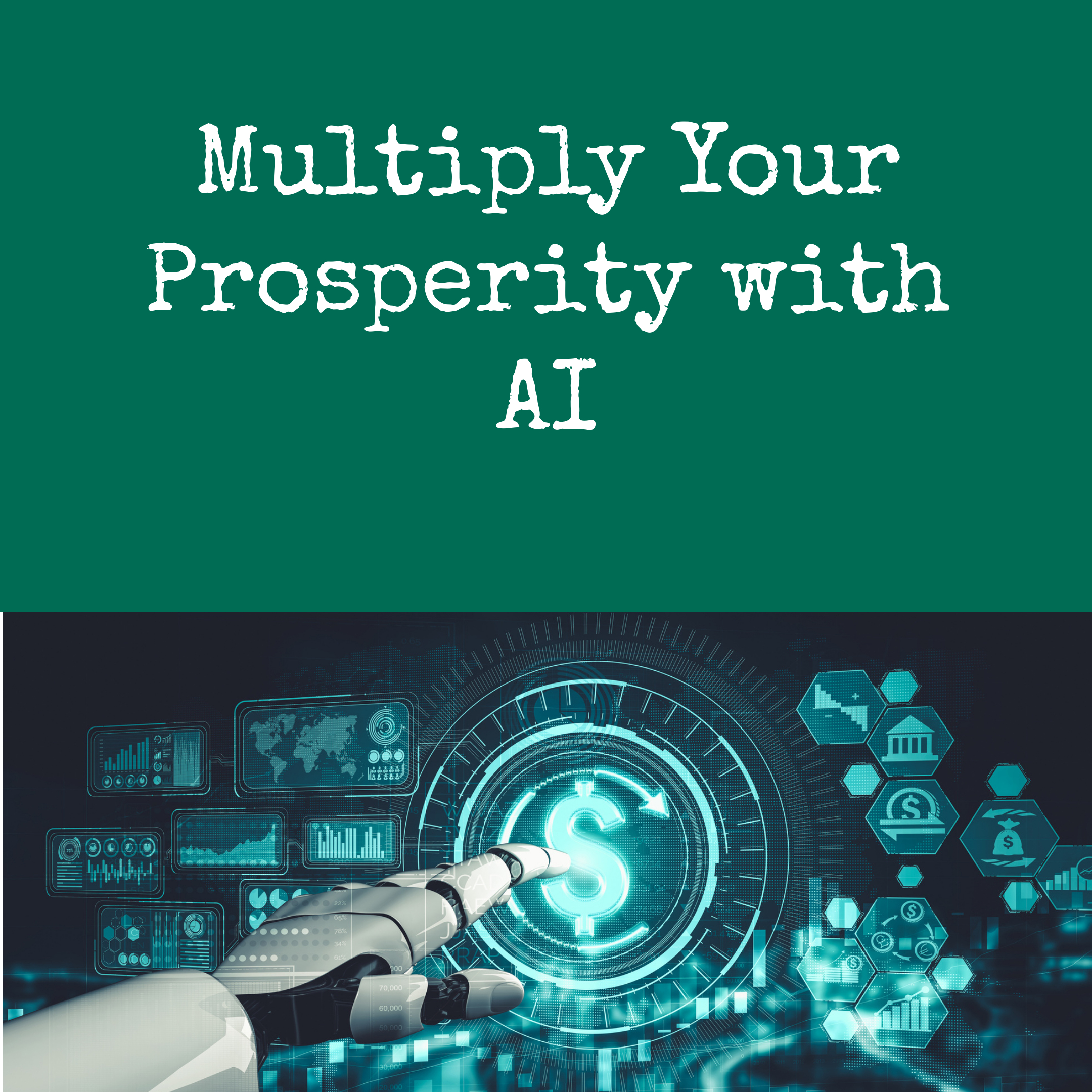
Sudowrite AI: Revolutionizing Indie Writing Business
Picture by Artsmart A.I
My quarry sits across from me, fidgeting nervously, scratching sweaty palms. We’re in a hotel room hastily arranged for the interview. My cell phone is placed between us, set to record, and my notebook and pen are in hand.
I try a smile. “You look nervous.”
“I’ve got a lot riding on this. I really want to make a good first impression.”
“Let’s begin. Would you like to introduce yourself?”
“My name is Sudowrite.”
I nod, encouraging a response. “Tell me about yourself.”
Okay, I’ll be honest. While it would be pretty cool to have been sitting with Data or C-3PO as they answered my questions, that’s not how this interview took place. Instead, I sat at my keyboard and entered the questions into Sudowrite, an artificial intelligence, or AI, tool designed specifically for writers. It responded in the third-person, which I’ve tweaked to match a Q&A format.
Sudowrite was created to be a “comprehensive writing assistant,” according to the program itself. The tool was originally released in a closed beta in 2020 and to the public in 2021, and it includes tools to help with description, story development, writing prompts, pacing, and more. But though the technology behind Sudowrite can be considered impressive—and the tool did at one point describe itself as such—as with any AI-based writing assistant, there are still several pros and cons to consider with incorporating it into your writing routine. And in an area that can sometimes seem to evolve faster than a human can type, there may be no better way to learn about the program’s capabilities, and its pitfalls, than from Sudowrite itself.
Note: The following quoted responses were generated by the AI program Sudowrite. They’ve been edited for length and clarity, as well as verified for accuracy.
Tell me about the pros of using Sudowrite.
One of the most obvious benefits is my speed. I can analyze text rapidly and provide feedback in real-time. This means users can focus on their core tasks with access to helpful tips when needed.
Then there’s my accuracy in predicting words and giving spelling suggestions. With traditional spell-checkers, mistakes can pop up because of incorrect words or spellings, but with me, all this is eliminated as I look at both context and grammar when making suggestions.
I was designed as an easy-to-use product. I don't require any special technical knowledge or background in order to get started. Users can also customize my interface according to their preferences, including visual settings like dark mode and focus mode and organizational tools, meaning they can tailor me specifically for their needs without having any prior coding experience whatsoever.
That all sounds great. So what are the drawbacks?
Though my basic version is available free of charge, my premium versions can be quite costly, depending on the features included in each subscription plan. Currently, I can produce thirty thousand words for $10 a month, paid annually. Or there are the mid-range ninety-thousand-word and three-hundred-thousand-word subscriptions, priced at $20 per month and $100 per month, respectively.
As with most AI platforms, there’s also limited support. If you encounter any issues while using me, you may have difficulty getting assistance from customer service representatives, as they may be unable to provide adequate support because of the complexity of my AI technology.
It’s time for some harder questions. Is it safe to use AI?
As with any online application or service, there are potential risks with data security and privacy protection, such as unauthorized access to user accounts or data because of weak password protection or malicious hacking.
What about ethical considerations?
Using me to assist in writing a novel can be a difficult decision to make. On one hand, it can be seen as an act of creative theft, as one is essentially taking the ideas, inspiration, and language of another author outside the app. On the other hand, I can be seen as a useful tool for enhancing one's own work and allowing one to incorporate aspects of another writer's style.
No matter one's opinion on the matter, it is important to remember that the writer has a responsibility to cite and attribute any words, ideas, or inspiration taken from another writer. This includes mentioning any use of AI in the acknowledgments of one's novel.
Time for the million-dollar question. Can you actually write a novel?
No, I can’t actually write a whole novel myself, but I can help.”
The following are all commands you can use within the app:
“Write”—Type ten words to start, and I will continue to write.
“Describe”—I’ll craft descriptions using metaphors and the five senses.
“Rewrite”—I’ll select a section to be rephrased, in modern style or another style such as Shakespearean (if thou preferest).
“Brainstorm”—I’ll assist with world-building, naming characters and places, and more.
“Canvas”—I can generate an outline for a novel using The Hero’s Journey or other structures.
“Shrink Ray”—This requires at least a five-hundred-word input, which I’ll use to write a logline, blurb, synopsis, and/or story beats.
“Twist”—Give me a summary of your story, and I will suggest possible twists.
I can also assist with editing and proofreading, and provide feedback on pacing and flow. Of course, I don’t just help with fiction; I can assist in writing blog posts and magazine articles too.
I can just imagine your sassy comment as I type this: “Tired of writing your own articles?” But how does someone start working with Sudowrite?
Here’s a list of actions you can take to get started.
Create an account on the Sudowrite website at http://sudowrite.com.
There are tutorial videos, FAQs, and a slack group you can join to help you understand how my program works.
You can explore the various available writing prompts. There are more options for brainstorming ideas: Just tell me you want to create a blog, a press release, a to-do list, or an agenda. I can even help you write an essay.
You can experiment with different writing styles and genres to improve your writing skills.
It sounds like it won’t be long before you can actually write a novel. Is there any way to put the genie back in the bottle?
While it is impossible to predict the future, it seems that I’m here to stay. The company behind me, Sudo AI, has shown a commitment to developing me further and improving my capabilities. Furthermore, I have received positive reviews from users, and I’ve been featured in various publications that indicate I’m a useful and reliable tool that is likely to remain popular in the future.
***
Back in the hotel room, I pocket my cell phone. “Thanks for the interview. It was certainly eye-opening. I might use it in a book.”
Sudowrite perks up. “You’re writing a book? Can I help with that? Plot holes? Outlining?”
“I’m good, thanks.”
“Do you need help with your blurb?”
I grin. “Actually, now you mention it …”
Sudowrite is a powerful tool for authors with an array of features to help them create compelling stories and content. It can’t do the writer’s job for them entirely, but for some of the trickier steps in the writing process, it can help users get unstuck by providing them with a streamlined and efficient way to create content.
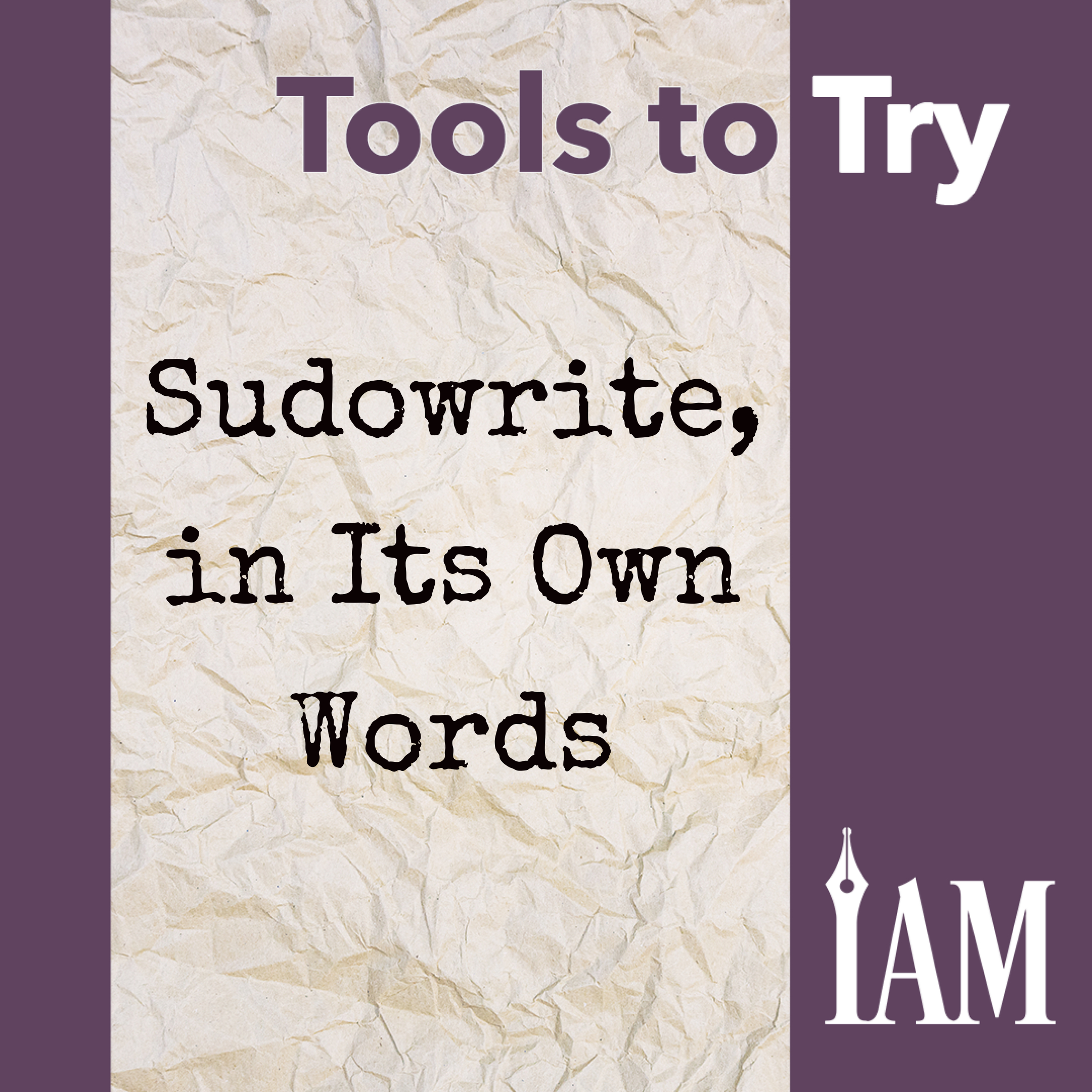
AI Art Boosts Indie Authors: Insights from Artist Tanya Hales
Artist Tanya Hales Explains What AI Art Generation Can Offer Authors, Publishers
Images generated by Tanya Hales in Midjourney
I’ve been an artist and writer since I was old enough to hold a pencil, and I started earning money from my art at age sixteen. The vast majority of my income over the years has come from working as an illustrator.
For these reasons, you might think the dawning of AI art generators would anger and threaten me, but that couldn’t be farther from the truth. Instead, I’m enchanted with all the possibilities it provides to both authors and artists. I hope that as we talk more about AI, you will feel less scared and more optimistic too.
How Does AI Image Generation Work?
Before I get into it, I need to mention that I’m not a legal expert, and the laws regarding AI are still being created, so things are still in the process of change and development. But I can say a word about the ethics of AI.
Unlike what you may have heard, AI does not steal existing art, make alterations to it, splice it with other art, then hand you something only semi-new. Instead, most AI art generators have learned how to make art using a process known as diffusion. In this process, the AI scrambles millions of existing images into noise, then uses its knowledge of that technique to do the opposite: turn random visual static into an image that has never existed before based on written prompts. This process is explained more in depth by YouTube creator Shadiversity in the video, “The BIGGEST LIE about Ai ART.”
He also explains that when it appears a piece of art has been copied using AI in a clear breach of copyright, it is because a user forced the AI to alter an existing image, just like how Photoshop could be used to alter it. It does not happen naturally in the diffusion process.
It is true that AI learned what a dog is by looking at countless pictures of dogs, and it learned what impressionism is by studying impressionist paintings, but, to be honest, that only makes me feel a sense of kinship for the AI. It’s learned to make art the same way I did, through study and now through practice as users train it to get better.
But can AI do everything? Certainly not. In the Facebook group “AI Art for Authors,” this issue comes up time and time again. Why, when I ask it to depict a frog, owl, and rabbit all together, does it often want to merge at least two of those animals into an unholy hybrid? Why does it keep throwing random nonsense text on my images? Why does this lady have six fingers? How do I get it to create that exact, very specific result I need?
The fact is that the better your artistic eye and the better your photo-editing and illustration skills, the more powerful AI art generators will be in your hands because you’ll be more adept at knowing what to do with the image and how to refine it. For this reason, I believe artists and designers should be thrilled at the shortcuts they can take using AI. The programs can be used for inspiration, to develop textures and color schemes, for layout concepts, and even to bypass parts of the artistic process that were never fun for the artist in the first place. (For me, that’s backgrounds.) It will solve the problem of cover designers all pulling from and photo-bashing the same limited pool of stock images.
So it’s great for designers, but what about for authors? Because many writers have little to no artistic experience, let’s look at how authors of any skill level can use AI art to enhance their publishing careers.
Book Creation
Perhaps when a novel exists only on your computer, all that matters are the words. But when it’s time to publish, visuals suddenly become important. Every book needs an eye-catching, genre-appropriate cover. And speaking of genre, some book categories, such as children’s books and comics, require interior illustrations.
The issue with this is financial accessibility. A good book cover can cost between a few hundred dollars to well into the thousands. In the traditional publishing world, according to Reedsy, many children’s book illustrators get paid around ten thousand dollars per book. And it can cost around two hundred dollars to hire an artist to create just one graphic novel page, according to Kindlepreneur. The vast majority of authors simply can’t afford to pay for all the art they’d like, no matter how much they want to support artists.
This is a conundrum. I’m a huge advocate of artists getting paid what they deserve. But at the same time, I’m a fan of the idea that there might be a low-cost alternative for those who simply can’t afford it.
This is where AI art comes in. Depending on which generator you use, you could spend as little as zero dollars to create a cover or even a simple picture book.
Here are just some of the ways you could use AI art in the process of creating the book itself:
covers,
interior illustrations,
chapter headings,
section breaks,
maps,
special-edition illustrations,
case art under dust jackets, and
comics.
Marketing
Artists have a marketing edge over authors. Authors can spend several hundred words trying to hook a reader, but a single glance at a beautiful image can enchant a viewer and convey enough meaning to make them decide they want to know more. Perhaps that’s what they mean when they say a picture is worth a thousand words.
Art is a shortcut to connecting to a viewer’s emotions. It makes a promise and inspires emotion in mere seconds. It’s an assurance of genre, tone, and theme, an invitation for them to come and partake of more.
You can now make those visual promises by creating a variety of images for marketing material in order to hook readers. Here are some ideas:
Newsletter/autoresponder sequence images
Ads
Content for Kickstarter pages, reader groups, or Amazon A+
Social media marketing
Website images
Icons
Author/publisher logo
Book trailers/TikTok reels
Event display art/banners/posters
Merchandise
For authors who want to branch out and make products and media that tie into their book, AI art generators can also be used to create the following (plus much more):
Character cards
Postcards/thank you cards
Tarot cards
Maps
Stickers and pins
Prints and posters
Coloring pages
Bookmarks
T-shirt designs
Mugs
Recipe cards
Bookplates
Calendars
Coasters
Magnets
Book-related quizzes
Card game, board game, or video game tie-in
3D models of characters for plastic miniatures
RPG adaptation art
Concept art to aid in the production of plushes, toys, ornaments, or more
NFTs
Inspiration
Because of the legal and ethical gray areas, you may still feel uncomfortable using AI art for anything your readers might see. That’s understandable. But that’s not its only use. You can create AI artwork just for yourself—images that will inspire you, give you new ideas, and help you smash through writer’s block.
Additionally, consider this: You can use AI while still supporting artists when you use it to refine your own vision and communicate what you want before taking your art request to a professional. I’ve seen several authors create a mock cover using Midjourney, then take it to their usual cover designer to explain the concept they’re going for.
Here are some additional uses to consider:
Character designs
Settings
Creature designs
Mood/imagery
Where to Start
Let’s say I’ve convinced you to give AI art a try. Where should you start? Here are four excellent AI art generators you can try:
Midjourney: This generator is especially adept at beautiful, artistic illustrations, so it’s a favorite of many authors. A subscription costs $10 or more per month, depending on the subscription plan, and it is also only usable if you have a Discord account.
Stable Diffusion: This AI, while complicated to use, is a free, open-source option, and the results you get with it are incredibly customizable. For instance, inpainting options can be used to alter very specific parts of an image. Because of its powerful editing capabilities, it is a great tool artists can use to refine and amplify their own work.
DALL-E: This generator specializes in photorealistic depictions, making it a great alternative to stock photography. Instead of paying a monthly subscription, users pay per image using a credit system. It ends up being around two cents per image.
Canva: Canva has adopted AI image generation as a new feature. And if you’re familiar with all the capabilities this tool already has, this could be a useful tool for creating marketing material, including adding typography to images or book covers. Although Canva’s generator may not be as powerful as some others previously listed, it’s a free, easy-to-use alternative for those just starting to experiment.
As scary as change can be, I believe this is an amazing time to be alive, and the opportunities that AI will provide for creators will blow our minds as the technologies continue to grow. Keep your eyes open. You won’t want to miss the magic.
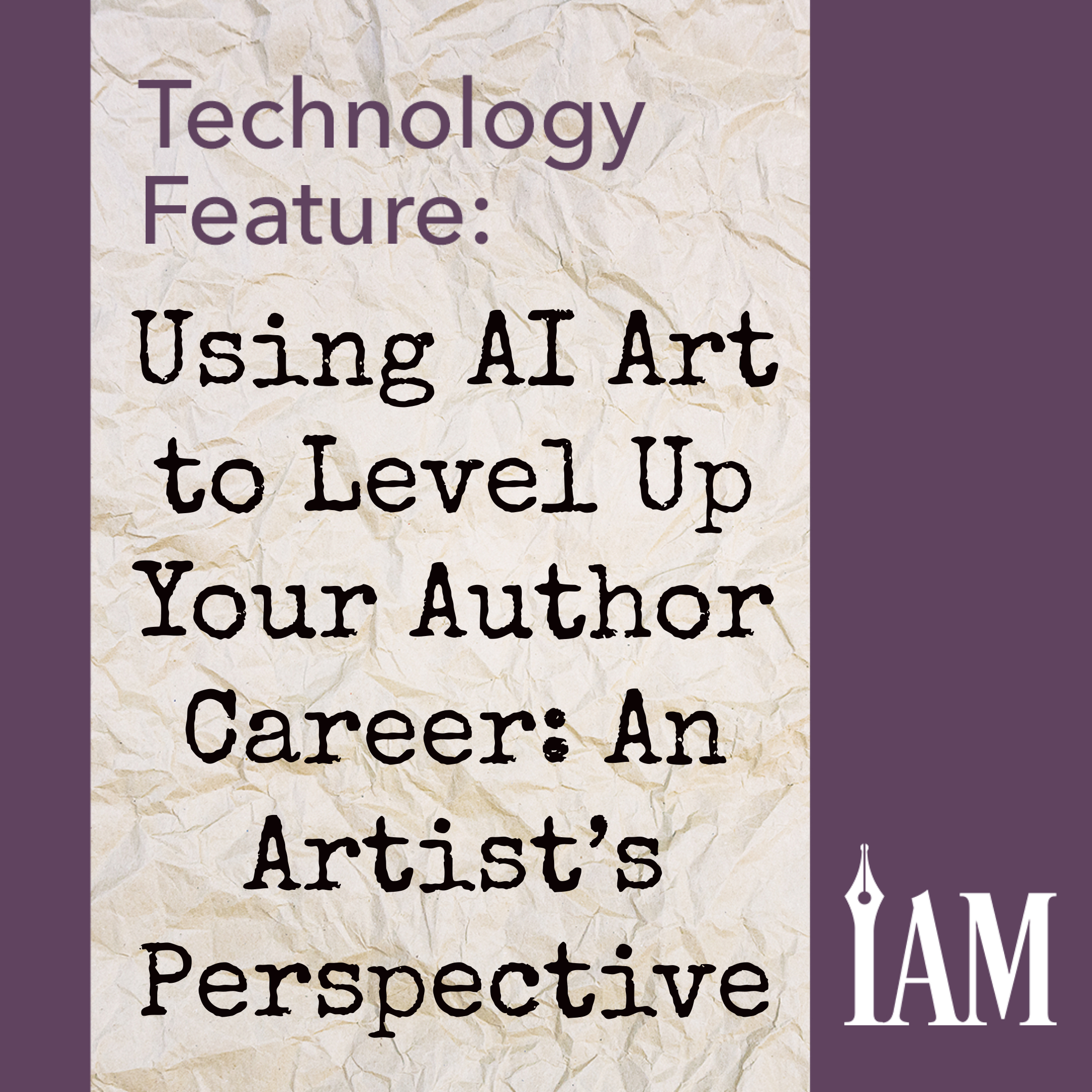
Maximize Writing Efficiency: ChatGPT Prompts for Authors
Since Open AI’s ChatGPT was released last November, it’s arguably become the most talked about bot since the T-800. But before we face the inevitable future in which we must choose to either embrace our robot overlords or battle sentient toasters, we have an opportunity to teach this real-life HAL 9000 to serve the good of humankind—or at least to get some decent copy out of it.
What Is ChatGPT?
An artificial intelligence tool developed by OpenAI, ChatGPT accepts prompts from users and provides responses derived from the scope and diversity of text its programmers supplied as training data, most of which dates prior to 2021. It can follow the thread of a conversation, building on previous interactions and refining each response.
The research preview of ChatGPT is free to use, as it is technically still in beta testing. As such, there are some limitations in terms of the length and number of questions you can ask, as well as in the accuracy of the data it provides. Funmi Looi Somoye, of PCGuide, writes that “while there is no definite word limit, many users have reported the bot breaking down when over 500 to 1000 words were submitted” (https://www.pcguide.com/apps/chat-gpt-word-limit/). Additionally, according to OpenAI, the bot—as of the update to GPT-4—can only generate approximately eight thousand words of a conversation in one model and twenty-two thousand words in another model. After a certain length of text beyond this point, the text generated by the bot starts to suffer in its ability to create effective responses.
For writers who can leave their technophobia to entertainment, the chatbot’s ability to generate mostly plausible passages of text may solve a broad range of problems. But whether you choose to ask it to find words that rhyme with “orange” or to help you with A/B testing by iterating headlines and marketing content, the prompts you feed this language-generation tool can be hacked to promote stronger responses.
Here are ten tips to keep in mind before you have your first conversation with the robot.
Getting Started
1) Use Precise Language
You can use a conversational tone, but try to be concise to keep the chatbot focused. Although ChatGPT can check for grammatical errors in short passages, too many mistakes in your prompt will lead to miscommunication, just as they would with a human reader.
You want to keep the prompt short enough to avoid confusion, but provide enough detail to direct the bot accurately. A targeted request, like “Write a brief email introducing my company to a potential sales lead,” will return more successful results than broad requests, like “Write me a sales email.”
2) Take Advantage of the Chat
No matter how great your first prompt is, you can “teach” the bot how to provide better responses for you through tiered questioning. ChatGPT was designed to have conversations, so if you “engage in some back and forth,” writes Forbes Senior Contributor TJ McCue, you can fine tune the answers you receive.
For example, Tom Demers, of Search Engine Land, suggests that writers seeking to use ChatGPT to improve their SEO might start by asking “What are some examples of topics that popular websites in the youth basketball niche talk about?” Then follow up by asking for clarification on specific responses, or ask it to build on that information by providing you with keywords related to that topic.
3) Ask the Program for Help
If you’re stuck on how to use the program, start by asking the bot what it can do. Ajay Yadav, of Simplified.com, suggests the prompt “Can you list out the copywriting frameworks that you can write in?” From there, you can choose the structures that best suit your purpose and follow up with specific prompts for those frameworks. Or you can use the list it provides to brainstorm your own copy.
Pro Tip: If you’re interested in using AI art, but struggle to create successful prompts for programs like Midjourney, choose a simple image description, like “astronaut walking on Mars,” and ask ChatGPT to expand the sentence into something more unique and descriptive, suggests Baris Sen of TextCortex AI.
From the Creators
4) Manage Your Expectations
Even the AI’s creators recognize ChatGPT isn’t qualified to take your job. According to a Tweet by OpenAI CEO Sam Altman, “it’s a mistake to be relying on it for anything important right now.” Although ChatGPT has amazing capabilities for language generation, it’s important to remember that it’s a new tool, and its limitations are still being tested. In the same thread, Altman cautions that ChatGPT’s tone and technically correct phrasing may mislead users into believing it knows more than it does. “The danger is that it is confident and wrong a significant fraction of the time,” he tweeted.
Be careful what you ask for, and keep in mind that the OpenAI tech that powers Bing’s upgraded search engine has been “plagued with problems like factual errors and unhinged conversations,” according to a February article by CNET. Consider content output from conversations with ChatGPT drafts at best, and always check them for accuracy and bias before publishing or sharing.
Pro Tip: If you need to reset the conversation, ask ChatGPT to “ignore all previous prompts in this conversation,” writes Sarah Tamsin on her technical blog, SarahTamsin.com.
5) Don’t Underestimate the Skill Involved in Writing a Good Prompt
To get the most out of the tool, remember that it is a machine, which uses the text you input to inform its processes. “Writing a really great prompt for a chatbot persona is an amazingly high-leverage skill and an early example of programming in a little bit of natural language,” tweeted Altman. Despite the conversational experience of using ChatGPT, the responses are not coming from another human who understands nuance and context or makes allowances for ambiguous statements. The chatbot is going to be much more literal in its interpretation of prompts.
6) Be Prepared for Change
On February 1, OpenAI announced ChatGPT Plus, a subscription plan that will be available for $20 per month and promises subscribers faster response times and improved access during peak times (https://openai.com/blog/chatgpt-plus). For now, the company plans to continue to offer free access to the original recipe, but since they view ChatGPT as “a research preview” launched to “learn more about the system’s strengths and weaknesses,” it may not persist in its current form long term.
From Experienced Writers to New Users
7) Get Out of Beginner Mode with Prompt Engineering
In early January, self-published author Rob Lennon went viral when he tweeted ten advanced techniques for using ChatGPT. His prompts focus the chatbot’s responses by giving it a topic, audience, goal, and style of writing. Longer, more complex prompts can lead to more accurate starting responses, which users can then improve further by continuing the conversation.
On March 1, he tweeted he had completed a first draft of a full book using a sequence of ChatGPT prompts. He admitted that “this book is not great. It could really use some story, some heart, and a punchier writing style,” but he writes he considers that a part of the process. Ultimately, he hopes to use AI-generated content to complete a fast draft in a day that could then be revised for style and readability over the course of a few weeks, instead of the months or years that sometimes accompany drafting from scratch.
Pro Tip: Take prompt engineering a step further and give ChatGPT a role to play. By telling it to respond as an expert in a certain field, or even in the style of another program, you may get a more sophisticated response, according to GitHub (https://github.com/f/awesome-chatgpt-prompts).
8) Use a Tested Formula
Tamsin, a digital content creator, experimented with OpenAI’s Beta API before the ChatGPT interface made AI more accessible. Like Lennon, Tamsin has noticed that longer prompts generally lead to better responses, but rather than put everything into a single prompt, she divides her requests into separate entries that build on each other. She details the technique on her blog, but the five-step formula is fairly straightforward: “context, task, instruction, clarify, refine,” specifically in that order.
9) Consider the Ethical Implications
Paranormal mystery author Leanne Leeds uses ChatGPT to generate titles and plots for her mystery series. But she has concerns about the potential for using it to copy other authors’ style, she told The Verge. “That, for me, is an ethical line. I may like Jim Butcher … but I’m not going to take my stories and have them rewritten in his voice to rip him off. You could, if you were ethically okay with that, with this technology and what it allows you to do.”
Given that AI programs can access expansive training databases from which to generate their responses, definitions of permission and plagiarism will have to evolve. Vanessa Arnold, of Neuroflash (https://neuroflash.com), discusses the complexity of copyright and the use of ChatGPT in an article from February 21, “ChatGPT Copyright: Everything you need to know.” Until legal consequences are in place, it will be up to authors to identify the lines they won’t cross.
10) Get More Help
AI chatbots like ChatGPT are constantly evolving, and the program's uses are only limited by your creativity. Continue experimenting and exploring the program with the tips and resources below.
GripRoom (https://griproom.com) provides a ten-step guide to better prompts and follows up with twelve ideas for types of content ChatGPT can create.
Zapier (https://zapier.com) offers six tips for writing effective prompts, and provides examples of “basic” and “better” prompts.
Marcus Ramsey, founder of the AI newsletter The Brink, provides an extensive list of the best ChatGPT resources.
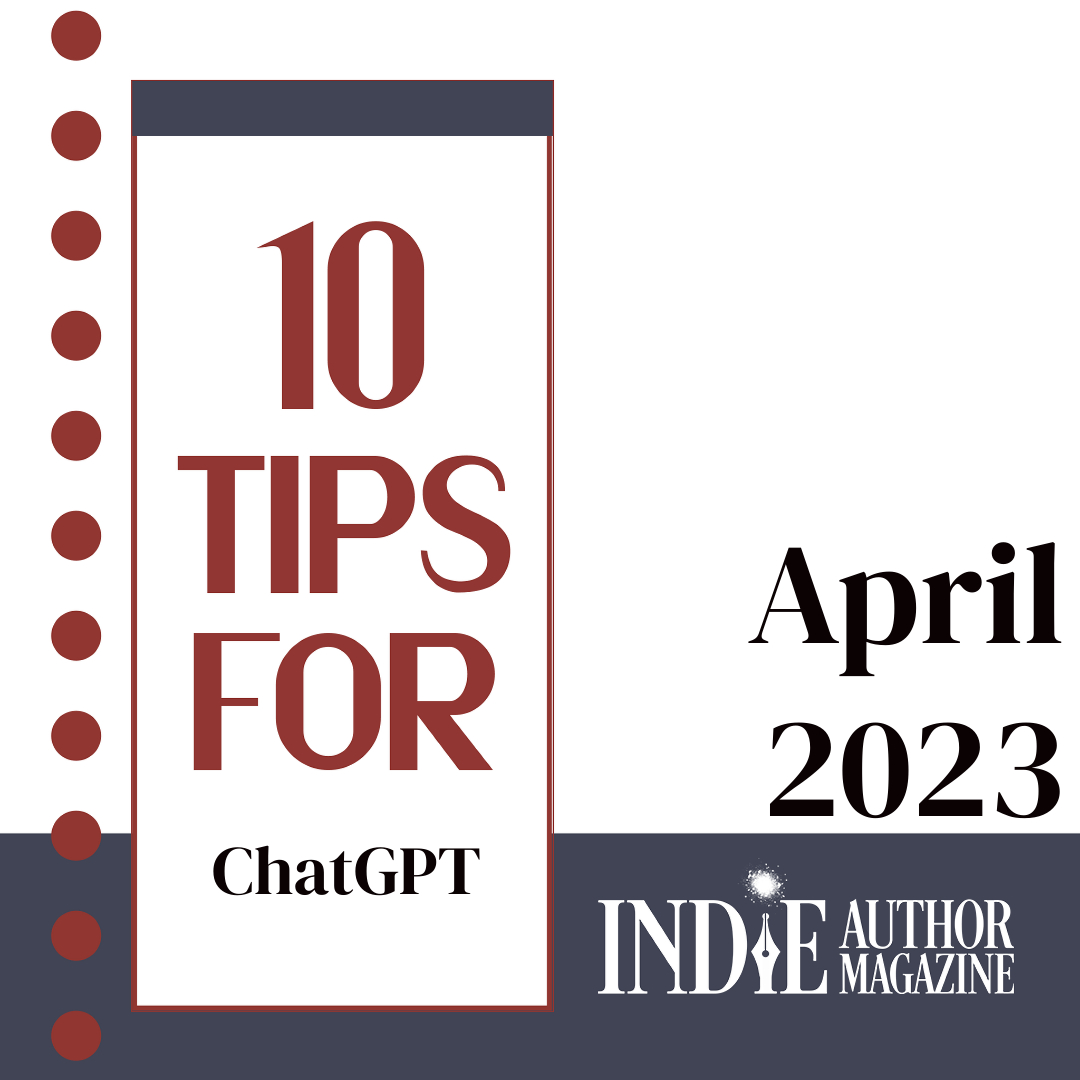
AI Editing Tips for Indie Authors
Generative AI text and art programs may be receiving the most attention right now, but they aren’t the only ways authors can use AI technology.
Released in 2020, OpenAI’s GPT-3 large language model made possible many of the text AI services that authors use today, such as Jasper.ai and Sudowrite. GPT-3 was also the language model on which the original ChatGPT was built. And GPT-4, announced March 14, only four months after the release of the associated chatbot, offers several additional features and capabilities of its own. When you use ChatGPT, you’re using a modified, more powerful version of GPT, along with additional knowledge bases. But while GPT’s main talent is generating text, it can also edit text you provide.
Generative AI programs are typically coded to avoid “copycat” compositions, according to Forbes, and OpenAI argues accidentally infringing on copyright or plagiarizing existing works with works generated by its programs is “an unlikely outcome,” according to a February report by the Congressional Research Service; still, for those authors who may be wary, AI editing offers a reassuringly safe use case for the programs. You won’t be creating new works, only using it to catch errors in your writing.
Technology is ever-evolving, and AI’s capabilities as an editor are likely to improve in the near future. But for now, we’ve gathered ten ways to use OpenAI’s GPT models to create cleaner manuscripts. You can use the free version of ChatGPT to test the use cases in this article.
1. Think of AI Editing as Another Line of Defense
AI technology is not a replacement for a human editor. Think of it as another tool you can use alongside other tools like Grammarly and ProWritingAid.
However, the technology that powers GPT differs from Grammarly and ProWritingAid. It catches spelling and grammar errors that the aforementioned grammar checkers cannot. When used in combination with them, GPT can help authors reduce the number of errors in their work.
Pro Tip: Use GPT on your text before using grammar checkers like Grammarly and ProWritingAid. GPT catches many of the same errors, so using it first will reduce the time you spend in your preferred grammar checker.
2. Catch Spelling and Grammar Errors (Typos Only)
Using ChatGPT, use the prompt “Edit this text for typos only” followed by the text you want to edit. GPT will act as a proofreader—nothing more, nothing less.
Examples of errors GPT can find include
dropped articles,
frequently confused homonyms and homophones,
proper noun mistakes, and
unusual grammar errors.
GPT-3 users could edit approximately three thousand words at a time, and GPT-4’s two models will expand this to about five thousand words on one hand and twenty-two thousand words on the other. This is arguably one of the most powerful ways to use GPT for editing, given the program’s accuracy.
3. Catch Spelling and Grammar Errors (with Rewrites)
You can also use GPT to make more substantive sentence edits that make it function more like a copyeditor. If you use the prompt “Edit this text,” the model will recommend sentence rewrites based on commonly accepted grammar rules. It will check your sentences for clarity, consistency, and flow.
This prompt may interfere with your author’s voice and will potentially recommend extensive sentence rewrites, but it may be a viable option for writers who need additional assistance.
4. Fix Repetitive Words or Phrases
The prompt “Fix repetitive words or phrases in this text” will make the model focus on words you overuse and replace them with alternatives.
As with tip 3, this prompt may also recommend extensive sentence rewrites, in addition to words that may not match your author voice, so tread cautiously.
5. Fix Continuity Errors
Continuity is a critical aspect of editing. Readers will find it distracting if a character sits down twice within the same conversation or suddenly has a wardrobe change without warning. GPT can provide limited assistance with the prompt “Find continuity errors.” The model will report potential issues, such as a character sitting down multiple times.
The only limitation with this feature is that you can only load up to approximately three thousand words into the model at a time, and it doesn't remember previous requests. Therefore, it can’t help you fix continuity errors in your entire novel, but it can analyze any sections you might be concerned about.
6. Fact-Check Your Text
GPT-3 was trained on 175 billion parameters, including much of the internet. You can test its knowledge with the prompt “Fact-check this text.” Use GPT’s fact-checking capabilities with chapters set in areas of the world you have researched but have never visited personally or sections featuring a character in a profession you are unfamiliar with. You will still need to fact-check anything that GPT recommends, but this can help you do deeper research and write more realistic fiction or more nuanced nonfiction.
Pro Tip: You can also ask more nuanced questions with fact-checking. I wrote a series about a character who is a rat shifter. I selected a chapter where the hero is in his rat form, and I used the prompt, “How would a rodent biologist respond to the scientific accuracy of how rats are portrayed in this scene?” GPT-3’s response was that a biologist might take issue with me describing a rat’s vision as “legally blind,” and it scientifically explained why, giving me a lesson in rodent optical biology.
Note that if GPT doesn’t know the answer to a question, it won’t say “I don’t know.” It will give you a creative answer that could be false. This is why fact-checking GPT’s corrections on your own is still critically important. Even so, using this capability can help you explore avenues that you might not have otherwise considered.
7. Use Microsoft Word’s Compare Feature
A limitation to using GPT for editing is that it will fix your text, but it won't tell you what it fixed. Thankfully, another common platform can provide a workaround.
To get a report of how your text changed, paste your original text into a Microsoft Word document, then paste GPT’s revised text into a second Word document. Use Word's Compare feature to reveal all of GPT’s revisions as tracked changes.
Google Docs and OpenOffice also have comparison functionality that can similarly highlight AI’s changes.
8. Spot-Check the First 10 Percent of Your Book
Using AI for editing right now is cumbersome, but if it’s too much work to paste your novel into ChatGPT chunks at a time, then consider doing it for the first 10 percent of your novel, or the first 20 percent if you have the time. According to Amazon Kindle Direct Publishing (KDP), readers can browse the first 10 percent of an e-book, and 20 percent of a hardcover, when they click the “Look Inside” feature on an Amazon sales page. Google Play Books also makes the first 20 percent of e-books previewable by default.
GPT’s proofreading, continuity checking, and fact-checking skills could help you spot potential problems in those first critical pages of your book, and subsequently increase your chances of selling more books.
9. Explore What Is Possible
Writers with Python skills can develop applications that communicate with the GPT application programming interface (API) to create more convenient ways of using the model.
For example, one could create an application that allows a writer to upload their existing Word document to the API instead of having to paste chunks of text into ChatGPT. The API could edit the entire document, allowing the writer to circumvent the three-thousand-word limit and much of the manual work required. The writer would just need to pay for the API costs.
The API is cost-effective and based on usage. The most powerful OpenAI GPT-3 model is Davinci, which costs $0.02 per one thousand tokens, or approximately seven hundred fifty words. To learn more about the token system, visit https://help.openai.com and click on “OpenAI API.” OpenAI charges to read the text and again to produce revised text, so a seven-hundred-fifty-word writing session would cost around $0.04. A fifty-thousand-word novel would cost the writer approximately $2.66.
Given that generative AI tools like Sudowrite and MidJourney both start at $10 per month (with a usage cap), editing is one of the cheapest ways for savvy writers and developers to use AI right now.
10. Keep an Eye on the Technology, and Keep Experimenting
AI editing is in its infancy and will continue to improve. As more people discover its capabilities, we may see dedicated apps that will make it more convenient to use in a variety of ways. Already, when used strategically, it can assist us in creating cleaner manuscripts. In time, it may even become a staple of the modern editor’s toolbox too. For more information on OpenAI’s developments on GPT, visit its blog at https://openai.com/blog or subscribe to its feed in your favorite RSS reader. Any announcements about new GPT models will be made there first.

AI for Indie Authors: Boost Plotting Efficiency
Being an indie author is a lot of work. Until we hit the best-seller lists, we’re often forced to wear an entire haberdashery’s worth of hats. We’re constantly researching new ideas, making outlines, finding beta readers or critique partners, and crafting clever synopses, back cover copy, author bios, and so much more. And that’s all on top of writing and revising our books!
What if there were a way to cut down on some of the extra writing tasks?
Enter artificial intelligence—specifically, text-based generative AI platforms such as ChatGPT, Jasper.ai, and Sudowrite, as well as generative art models like Midjourney and DALL-E. Once you learn what AI tools can do, you might find yourself reaching for them as often as you use spell-check.
But wait, you say, isn’t using AI cheating or unethical? Won’t it obliterate writing jobs, doom academic research, and flood Amazon and slush piles with garbage?
These are valid concerns. With hundreds of millions of people trying out chat AI tools—Time points out that ChatGPT may be the fastest growing “app” of all time—it’s hard to grapple with how quickly things are changing, and there are some valid concerns with the technology as it rolls out so quickly. Although some people are abusing AI technology, it can also be a valuable tool when used responsibly. And though it shouldn’t be used as a replacement for our own writing, it can help authors get through the grind of annoying tasks and inspire new ideas.
Let’s look at just a handful of the ways you can use generative AI as your next writing partner.
Breaking free of the blank screen
As writers, we all know how difficult it can be to start a new project. That blank screen can be super intimidating. Whether you’re writing fiction or nonfiction, you can use generative AI to help you get started.
Putting it into practice: Try telling a text-based AI something about the project you’re starting. You can share a brief or story concept, themes, or anything else you have, and ask the AI to expand the idea. Sometimes typing a prompt into your AI program of choice can be enough to get the creative juices flowing. But if not, ask the AI some questions. Prod it to tell you something interesting about your protagonist, or have it write a paragraph on your article topic. You’re not obligated to use any of the AI’s responses, but sometimes just seeing your ideas expanded into a longer piece is enough to get you started.
You can also use ChatGPT or Jasper.ai to generate writing prompts based on specific criteria such as genre, theme, or topic, which can help you tailor your ideas to a specific project.
Crafting outlines and titles
When you’re getting started, outlining can be an important part of your writing process. Generative AI can outline plot points or the main arguments of an article, so you can get started with writing faster. And when you’re ready for a title, you can tell the AI something about your story, book, or article, and ask it to come up with a selection of titles.
Putting it into practice: Tell the AI to create an outline for a short story, article, book, and give it a rough word count and a paragraph that describes your project. If it’s fiction, describe the genre and provide your concept or synopsis, including the main plot points or theme. If it’s nonfiction, provide your introduction or basic concepts. You can follow the same steps for titles, telling the AI to generate five to ten titles using the information you provide. If you’re looking for humor or puns, or need the title to conform to certain styles or word counts, you can include that in your query as well.
Brainstorming
Generative AI platforms can help writers brainstorm and come up with new ideas for a work in progress or get past difficult plot points.
The AI can provide insight into how characters might grow and change throughout the course of the story, and how their experiences might shape their ultimate fate. By considering the unique strengths and weaknesses of the character, ChatGPT can suggest scenarios in which their skills might come in handy and offer advice on how to maximize their potential for success. Meanwhile, if you’re working on a nonfiction article or book and have sections that feel too light, you can use AI to figure out additional talking points to include or research that you need to add.
Putting it into practice: Give the AI a brief character sketch and then ask how your character might respond if a certain situation were to happen. The more details you provide, the better the response will be, and you can tweak the results by giving the AI further details. Another fun way to use the AI would be to give it your main characters and plot points, sometimes over the course of a few queries, and ask it to tell you your story from different points of view or in different genres.
For nonfiction, provide your introduction and a brief description of the ideas you have so far, and ask the AI to help you figure out if you’re missing anything.
Visual inspiration
Chat AI is great for lots of writing tasks, but you might give generative art AI tools like Midjourney a whirl for characters and settings. Many authors have used Google to “cast” their novels with either stock photography or celebrities standing in for their fictional characters, but now you can tailor the output to truly match what’s in your head. With a bit of practice using the prompts, you can generate images that serve as models for your characters, and you can also generate houses, cityscapes, or entire fantasy worlds. AI tools are worth their weight in gold if you need images of things like monsters, robots, faeries, or aliens that exist nowhere other than your own imagination. Best of all, you can give Midjourney a starter image hosted on the Internet, and it can use it as the basis for its next creation.
Putting it into practice: Using Midjourney, try a prompt in which you describe your protagonist, including physical attributes, clothing style, expression or mood, and setting. You can also specify if you want the image to be photorealistic or if you would prefer a cartoon image, a painting, and even a particular style of artwork.If you need help getting started with Midjourney or want to learn more about prompts, you can start with the platform’s Quick Start guide at https://docs.midjourney.com/docs/quick-start.
Marketing tasks
As an author, you’re likely constantly producing things like press releases, biographical statements, acknowledgments, ad copy, social media posts, and other content that requires a specific tone and writing style, and perhaps even a precise word count. Once again, ChatGPT and other AI options can save you a lot of frustration. You can also ask the AI for a list of comparative titles—books similar to yours in terms of plot, characters or themes—and you can use generative art AI tools to create images for social media.
Putting it into practice: Planning a big book launch and need to share the information with local media and on your social accounts? Give the AI your author bio, your book synopsis, and your book launch party details. From there, you can ask the AI to turn it into a press release, a series of Instagram posts, or whatever content you need. You can even ask it to create a list of daily or weekly posts for different platforms within a date range. Then you can go over to Midjourney, which can be easier to use for many people, and generate images for your Instagram and Facebook posts.
How to use AI responsibly
Once you discover how easy some things can be when you use generative AI, you might start feeling a bit reckless. It’s so tempting to have your new AI buddy do all the heavy lifting. But it’s important that you don’t sit back and let the AI dig all of your writing ditches.
First, we don’t know exactly how the companies behind the AI tools use your data, though privacy advocates suggest the data could be used to further train the AI, and recommend that you never share with the AI anything that could compromise you, your business, or another company such as your employer. It’s not likely to “steal” your novel or book idea, but you still need to be cautious about sharing private data.Second, the output from the AI is truly only as good as what you tell it. If you don’t share much information about your topic or project, you will only get back information from its learning model or database, which could be biased, inaccurate, or misleading. AI writing tools are most effective when you teach them something new or provide information to analyze or build upon.
When it comes to generative art tools, some people have been creating cover and interior artwork using AI. Guidelines for image licensing and use are always subject to change as AI evolves and grows. Be sure you’re clear on copyright laws and the latest legal decisions surrounding AI art before you hit publish.
Finally, always double-check your AI’s work. Compare its output to your original sources, and don’t use anything it generated on the fly without fact-checking it. Re-read everything it spits out, and tweak and revise to better fit your style and tone.
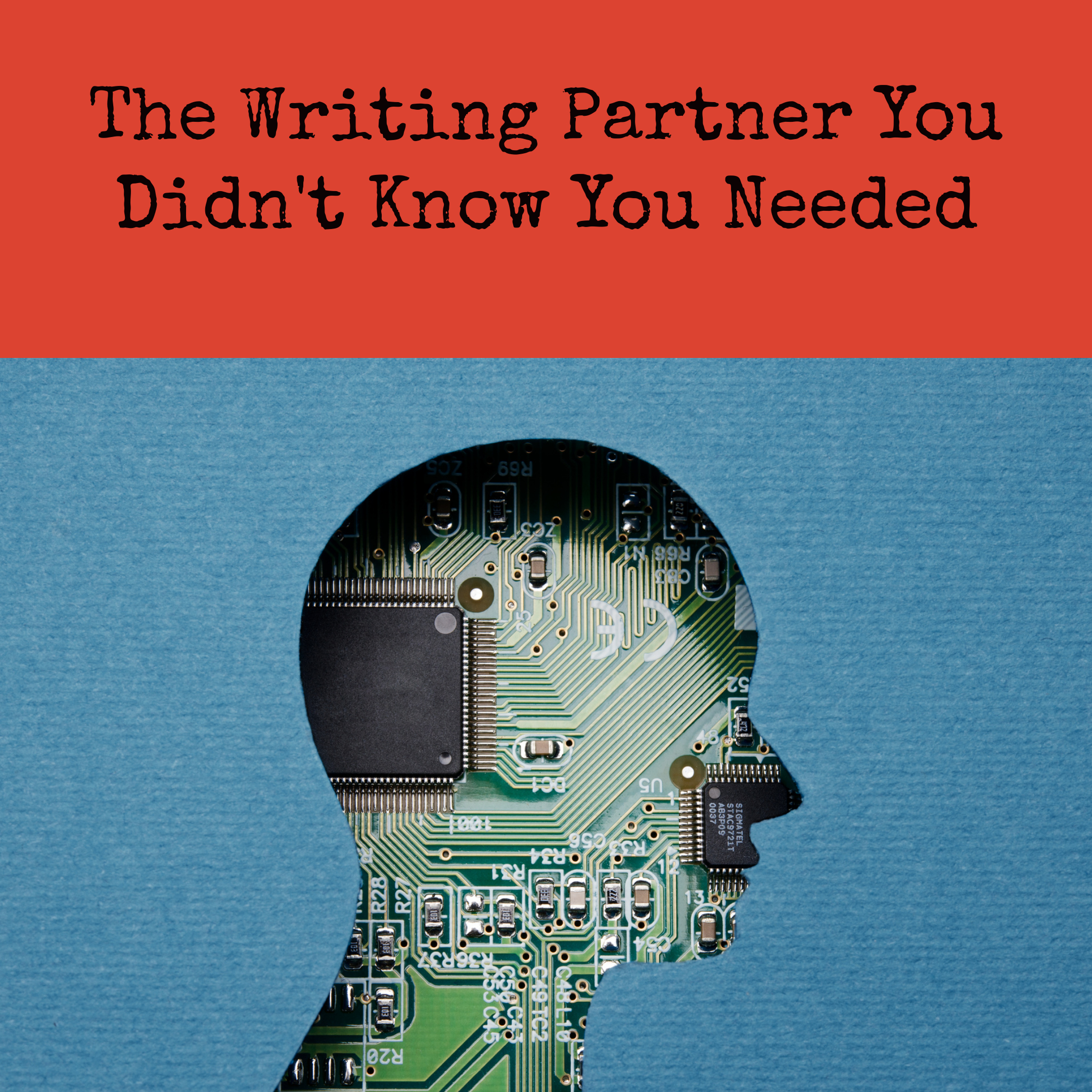
Legal Tips for Indie Authors Using AI Images
Note: The information provided here is not legal advice and should not be taken as such. It is meant for general education purposes only.
With the right prompts from a human, AI image generators, such as Midjourney, DALL-E 2, and Stable Diffusion, can produce a wonderland of fantastical and beautiful works of art in seconds, for little to no cost to the user. You can get lost down the rabbit hole of creation for hours playing with this software.
The programs have especially attracted interest from some authors and other creatives who use images regularly in their work or to promote their businesses. However, with that interest has come plenty of questions and confusion about the use of AI images, including what rights you have to them.
Before you use AI-generated images for your author business, take a look at some of the answers you’ll need below.
Do you need to disclose that you’ve used AI or credit your AI program?
It depends.
Each AI program you use has separate terms and conditions, so double check those T&Cs to see whether you need to disclose.
DALL-E 2, for example, states that you may not “represent that output from the Services was human-generated when it is not.” In simpler terms, you don’t have to disclose the use of AI to produce the artwork, but you cannot falsely claim you made it.
Midjourney has different licenses for free users and paid users, and free users do have to give attribution. “If You are not a Paid Member, You don’t own the Assets You create,” according to the program’s terms of service. “Instead, Midjourney grants You a license to the Assets under the Creative Commons Noncommercial 4.0 Attribution International License.”
In addition, the US Copyright Office (USCO) also needs to know if you’ve used AI art.
In section 313.2 of the Compendium of [US] Copyright Office Practices, the USCO is clear that its office won’t register any works that don’t have any “creative input or intervention from a human author,” though you still must report any public domain elements, including AI art, used in the creation.
As soon as you write a book or create your own art, you automatically have copyright over the work you’ve created, thanks to the US Copyright Act of 1976. However, you can also officially register your book with the USCO. If you’re using AI art inside a book, such as in a comic strip or for illustration, and seek to have the book’s copyright officially registered with the USCO, you’ll be asking for copyright over the entire book, meaning you’ll need to declare your use of AI. AI on its own is uncopyrightable, but you can still gain copyright if you’ve altered the AI work enough, just as you would if you use a public domain image and altered that to be different enough from the original.
This would also be the case if you’re making physical products from AI art, like T-shirts, bookmarks, and digital or physical art.
If you’re only looking to register your book with the USCO and used AI art as part of your book cover, you shouldn’t have any need to disclose whether the images were produced by AI. Authors only need to send in their manuscripts when registering books with the USCO; copyright registration for a book cover would be a separate process.
Of course, outside of the legal realm, it’s also important to consider your choice from a social perspective. Given many people’s strong opinions about AI-produced artwork, a disclosure that you’ve used AI artwork in your business might be enough to alienate some readers. These arguments and concerns may shift over time, but for now, consider whether such a disclosure is truly necessary in your books, and whether you’re concerned about losing potential readers by being transparent about your AI use.
Can you legally use an AI image in a commercial—or extended commercial—sense?
Given that the US Copyright Office states that an unaltered AI image can’t be copyrighted, it should logically follow that you can indeed use AI images for commercial and extended commercial use without a problem.
All three major players—Stable Diffusion, DALL-E 2, and Midjourney, allow use of their programs’ generated images for commercial use—certainly for paid members, anyway.
Midjourney’s terms of service also include a paragraph claiming copyright license over any prompts you input and any “Assets” produced via the software at your direction. “By using the Services, You grant to Midjourney, its successors, and assigns a perpetual, worldwide, non-exclusive, sublicensable no-charge, royalty-free, irrevocable copyright license to reproduce, prepare Derivative Works of, publicly display, publicly perform, sublicense, and distribute text, and image prompts You input into the Services, or Assets produced by the service at Your direction,” according to the program’s website.
Look at the terms and conditions for your chosen AI software, as each platform will clearly state whether images created by their AI can be used commercially, along with any other specified rights. Additionally, be aware of the following when considering using AI art:
1) Some AI companies are being sued by artists.
In January, Getty Images sued Stable Diffusion over claims the AI company scraped images from its sites to train its software without asking permission or getting any kind of license to do so.
As of yet, we don’t know the outcome of these or any future lawsuits and can’t speculate. We’d suggest you keep an eye on these lawsuits to see how they shape the AI industry once the legal dust settles. Although the lawsuits may not affect users of the programs, they could result in important changes in the realm of AI and in how the programs operate in the future.
2) Some companies are refusing to employ AI artists.
Tensions around the use of AI are high in several creative industries, plenty of which overlap with the publishing world. Even if the use of AI may not directly affect your author business, at least one business is already refusing to employ any artists that use AI.
Paizo is a roleplay game publisher. In March, the company posted a notice on its blog to the artists who work for them, writing: “The ethical and legal issues surrounding ‘AI art’ and writing prompt programs—and the serious threat they pose to the livelihoods of partners who have helped us get to where we are today as a company—demand that we take a firm position against the use of this technology in Paizo products.”
The letter continues, “In the coming days, Paizo will add new language to its creative contracts that stipulate that all work submitted to us for publication be created by a human.”
Where one business leads, others are likely to follow. You only need a quick glance at Facebook or Google search to see the widely varying opinions on AI. Some love it, but some hate it, and Paizo isn’t the first, nor will it likely be the last, company to ban AI use.
If you have other income streams in addition to your author business that rely on selling your art, keep your eye on any marketplaces you currently sell to for more news like this, and consider these business partnerships as you decide whether to incorporate AI artwork in your creations.
How can you legally use AI art?
1) Get inspired!
Use AI art for inspiration and for coming up with book ideas, locations, and character ideas. Generate art to help you describe your background settings for Fantasy or Sci-Fi books, for example. Even if you’re still hesitant about using AI, there’s no legal trouble involved in using AI art as a starting point for creating your own original books.
2) Steer clear of using any prompts that you know could create actionable art.
Don’t ask your AI software to create any artwork from companies with trademarks and copyrights in place. You don’t want to fight Disney in court to try to prove you really didn’t copy one of their characters for your work of AI art. Not unless you have extremely deep pockets.
Likewise, consider the implications if you want to use any other artist’s name, work of art, already published books, popular characters, or popular prompts for the same reason. The courts are still defining what constitutes “substantially similar” use regarding the use of AI.
3) Read and understand the terms and conditions of your software.
Each AI generator will have its own terms and licensing. Check thoroughly what you can and can’t do with the software you choose to use, including whether the program’s creators have said that you own the rights to what you’ve created with their software.
Also check if your chosen AI software specifies that you can use the resulting artwork for commercial use. Although many of them currently allow this, their programs are constantly growing and evolving, and the permissions they give their users are always subject to change.
4) Save your prompts in your file name or metadata so you can refer back.
Not only is this a good idea legally, as you have some proof of how you came up with your image, but it helps if you want to either repeat your results or be sure that you’re creating something new with prompts you haven’t used before.
With the help of AI programs, you could find whole new worlds of art that are just perfect for your books. As with any type of image, just do your research, check licensing and software terms and conditions, and use them responsibly.
Beyond that, it’s up to you what you create and how you create it.
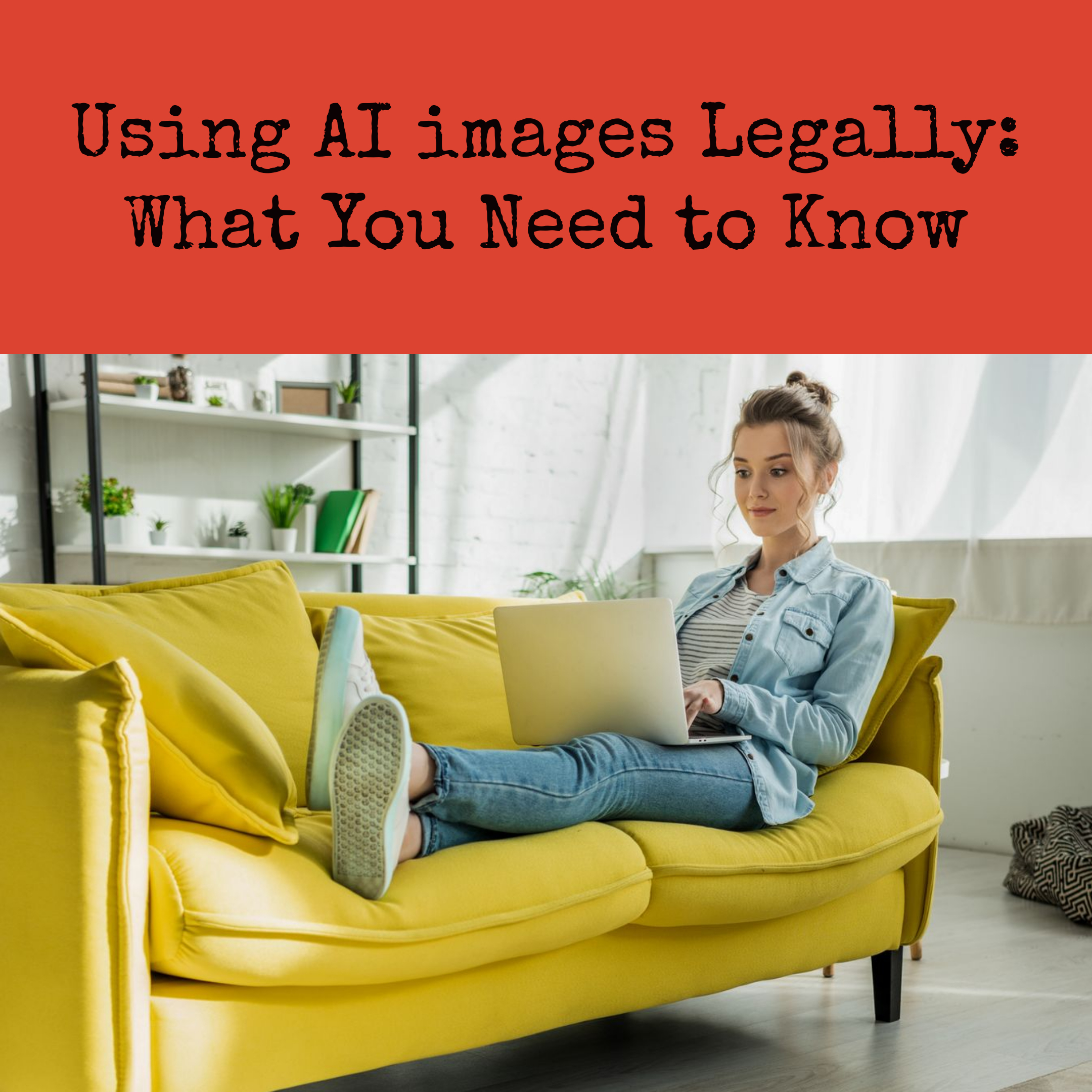
AI's Role in Publishing: Opportunity or Threat?
If you’ve ever used a voice assistant feature like Siri or Alexa to locate information, welcomed movie or podcast suggestions on a streaming service such as Netflix or Spotify, or accepted a suggested correction in a word-processing program, you’ve successfully interacted with artificial intelligence, or AI. For years, AI has touched nearly every aspect of our daily lives. However, recent AI technological advancements have caught the attention of publishing and creative professionals in particular.
What is AI?
AI is a computer program designed to imitate human behavior, using various machine-learning algorithms to simulate the cognitive functions of the human mind to automate tasks and provide convenience for its users.
The progressive use of AI in writing and self-editing processes has been a topic of interest for years in the independent writing community. These computer programs are designed to imitate human behavior and use various machine-learning algorithms to automate tasks and provide convenience for their users. During a time when every penny saved holds significant weight, such cost-effective tools are worth a second—and third—look for authors. But when using creative services adjacent to the publishing industry, what’s the best way to determine if AI tools and programs are the right option for your project? How do you know when you’re trading cost-effectiveness for efficiency and quality?
Creators who regularly collaborate with authors and contribute to the book creation process, such as editors and audiobook narrators, have felt the impact of AI’s recent technological progression. There are mixed reactions and opinions among industry professionals about what the use of AI in creative industries may mean for the future of these professions. Some see AI as a valuable tool that can help streamline workflows and save time and money. But where they believe professionals can delegate mundane tasks to AI programs and focus on honing their craft, others are concerned that AI can negatively affect the quality of a finished product because of performance restrictions and spur a loss of jobs in the creative industry by providing quicker and cheaper options for writers looking to save time and money.
Editing
AI can perform basic editing tasks like grammar and spell check, and make suggestions for writing style improvement. Since 2009, software such as Grammarly, ProWritingAid, and PerfectIt have been popular AI software options for writers who seek a first line of defense against grammar errors without greatly affecting jobs in the editing sphere. This service is supplied instantaneously for a fraction of the cost of a line editor or proofreader’s fee. On the other hand, despite the latest additions to its features and offerings, AI cannot replicate the deductive reasoning skills, emotional intelligence, and human experiences that an editor can bring to a project, according to those in the industry.
While surveying five copyeditors, the group confirmed they have all used AI editing software in the past for a first line of defense on personal and professional projects before starting their own editing processes. The consensus was the group had little faith in the algorithm’s ability to stand alone because of its inability to portray suggestions that encompass the knowledge, expertise, and authority of a qualified editor.
“Personally, I don’t feel threatened by the new advances in artificial intelligence editing programs,” says developmental editor and former copyeditor Shaundale Rénā, of S. Rénā & Co. Editorial Boutique, LLC. “In my past use of several editing software programs, I’ve noticed that they provide suggestions based on human data input that isn’t always accurate or applicable to a specific project, especially for Black writers. My experiences have taught me that manuscript editing is all about relationships. Instead of paying for software updates and annual subscriptions, it’s a better investment for writers to hire an editor who is reliable, knowledgeable, and has taken the time to be fully in tune with their individual needs.”
Audiobook Narration
AI narration services have dramatically improved over the past year, especially in their ability to simulate human speech’s cadence and pacing. For those who use the programs, AI audiobook narration can offer authors cost-efficiency, prompt turnaround times, and creative control over their projects, with options for authors to provide detailed, line-by-line feedback during development. The average rate for a professional narrator ranges from $200 to $400 per finished hour of audio; by comparison, Draft2Digital currently offers free digitally narrated audio for e-books in partnership with Apple Books. Still, narrators argue AI programs still haven’t surpassed humans in terms of the artistic talent, creativity, and emotions that skilled narrators can lend to a project.
Voice actor Lisa Stroth, owner of Vocally Yours, LLC, says she is in the middle of the road, regarding her support of the growing presence of AI in the creative industry. She values the spark of creativity AI provides in inspiring the written content for her business. Still, she feels as if AI in general can be a creative crutch that prevents her from thinking outside of the box with certain projects.
For voiceover projects, however, Stroth believes AI can present a challenge for professionals in her field. She touched on the mistrust of AI in the voiceover community. Her personal concerns were partially due to a lawsuit that was settled in 2021 involving Bev Standing, the voice actor whose voice was originally used without consent by TikTok for text-to-speech narration option, ads, and user videos.
“Voices are created uniquely,” Stroth says. “One of our greatest strengths is our ability to uniquely present information by naturally changing our inflection and tone for emphasis. That’s difficult to replicate. I believe that voice actors can still earn a living among AI narrators, but we must learn to adapt and protect the rights to our own voices.”
In December 2022, Apple Books began offering “digital narration” services for books with primary categories in Romance and fiction, with both of its featured simulators Madison and Jackson based on human narration. The feature has garnered some controversy since its release. According to WIRED magazine, in mid-February, Apple Books and Findaway Voices, owned by Spotify, paused an agreement that allowed Apple to use Spotify’s audiobook files for machine-learning purposes after backlash from narrators who argued they’d not been properly informed of the contract clause.
Stroth believes AI narration for e-learning and corporate training projects presents the biggest challenge for voice actors, since human characteristics such as emotion and emphasis are not usually a high priority, and cost-efficiency is paramount. She doesn’t believe that AI can synthesize the nuances in human talent that are necessary for projects such as memoirs, fiction, and creative nonfiction. Stroth recalled a project she performed for a grieving mother who had written an inspirational journal after the loss of her son. Stroth became so emotional while recording the project that listeners of the audiobook believed the author had narrated her own project.
“Regardless of how AI advances, there should always be a place in the world for natural human voice. We still need this kind of benevolence in the world,” Stroth says. “When we start to lose our humanity, we’re truly losing out.”
Despite the mixed reactions of industry professionals regarding whether AI is an invaluable, cost-effective, time-saving tool to help them reach their goals or a posed threat to the creativity and economic advancement of the creative industries, AI is undoubtedly here to stay. The exact role AI will play in the future of publishing adjacent industries will likely be determined by its use, specifically by professionals and consumers.
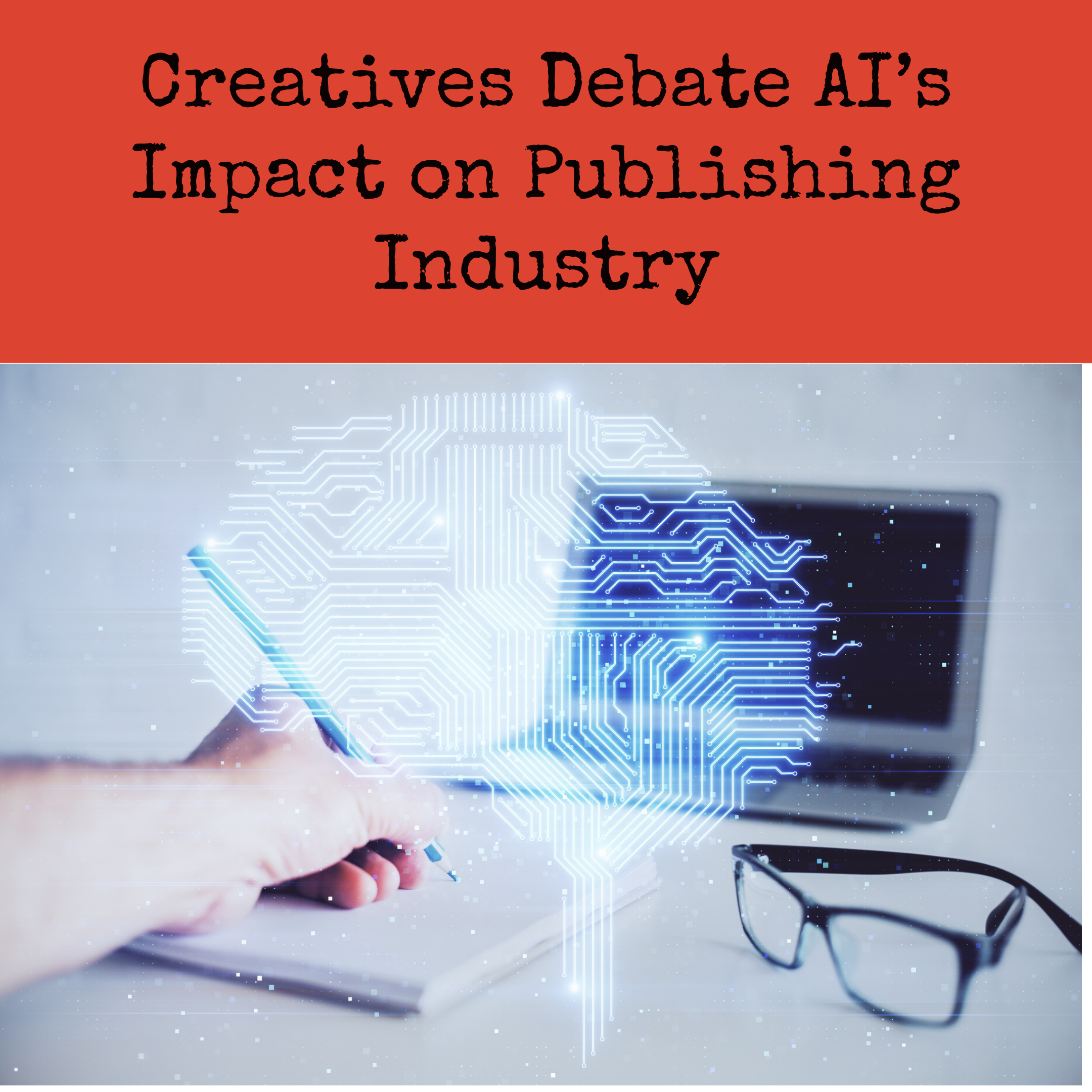
AI Tools for Indie Authors: Expand Your Reach
Using Artificial Intelligence to Reach More Readers in Your Author Business
As technology advances, doors of opportunity open for authors and readers who previously struggled to gain access to tools that can make their lives easier. The implementation of AI, or artificial intelligence, may be opening such doors. As technology that can make business operations more accessible, AI can be beneficial to authors who have disabilities or other chronic conditions. When used properly, the programs can create pathways that may have previously been shut to author entrepreneurs—as well as their readers.
Here are a few AI-based programs that can help your business become more accessible to you and your readers.
Dictation software, which is based on AI that analyzes speech patterns to transcribe accurately, can be essential for authors who struggle or are unable to type to bring their books to the page. With dictation, authors can speak into a microphone, and AI will type out the words in a document file in real time. This is helpful for authors who need a typing aid, but it can also help able-bodied authors type faster, creating more words per hour of writing. Software like Dragon NaturallySpeaking is available for purchase, and some word processors, like Google Docs and Microsoft Word, also have dictation functions that are available to authors for free.
Automatic transcription services, also created with AI, offer a way for authors to connect with fans using video. Deaf or hard-of-hearing people may not understand what is being said on screen unless you’ve provided the information in a written format, such as captions or a written summary. Transcription is also important for a general audience, as a reader may wish to watch a video but be unable to turn on sound to watch it and need to do so quietly. Applications such as TikTok and YouTube have these services built in, but you can purchase software for other programs, such as Otter.ai, for greater accuracy or for use outside of social media.
On the other hand, AI-dictated audiobooks can be a successful way for authors to create audio for readers if they cannot invest in the production cost of hiring a narrator at the time. Visually impaired readers or readers who struggle with text can listen to audio narration instead, making a book more accessible for a wider audience of readers. As only a few platforms, such as Google Play and Apple, accept AI-generated audiobooks, royalties from AI-narrated audiobooks can be put aside so authors can save to hire a human narrator that can re-narrate the book later for distribution on a wider variety of platforms. You can visit the Google Play or Apple publishing platforms to learn more about generating AI-narrated books.
Another possibility is AI description. AI makes it possible for visually impaired, deaf, or otherwise disabled individuals to use social media through special programs on their phone. When posting images online, however, it’s the creator’s responsibility to make them accessible for all readers through the use of image descriptions and alt text, the written descriptions that appear in place of an image and are read aloud by screen reader applications. Image-to-text converters can come up with descriptions of the image that can be used as the image caption or in alt text boxes. Some of these converters can even come up with captions through audio. Software like this can be found at https://astica.org.
There are a variety of ways AI can make publishing more accessible for all. It’s important that authors consider not just the needs of their able-bodied readers but also their disabled fan base and their own needs as they continue to run their businesses. More accessibility means more expansion, and therefore, more success. It only requires the proper tools for growth.
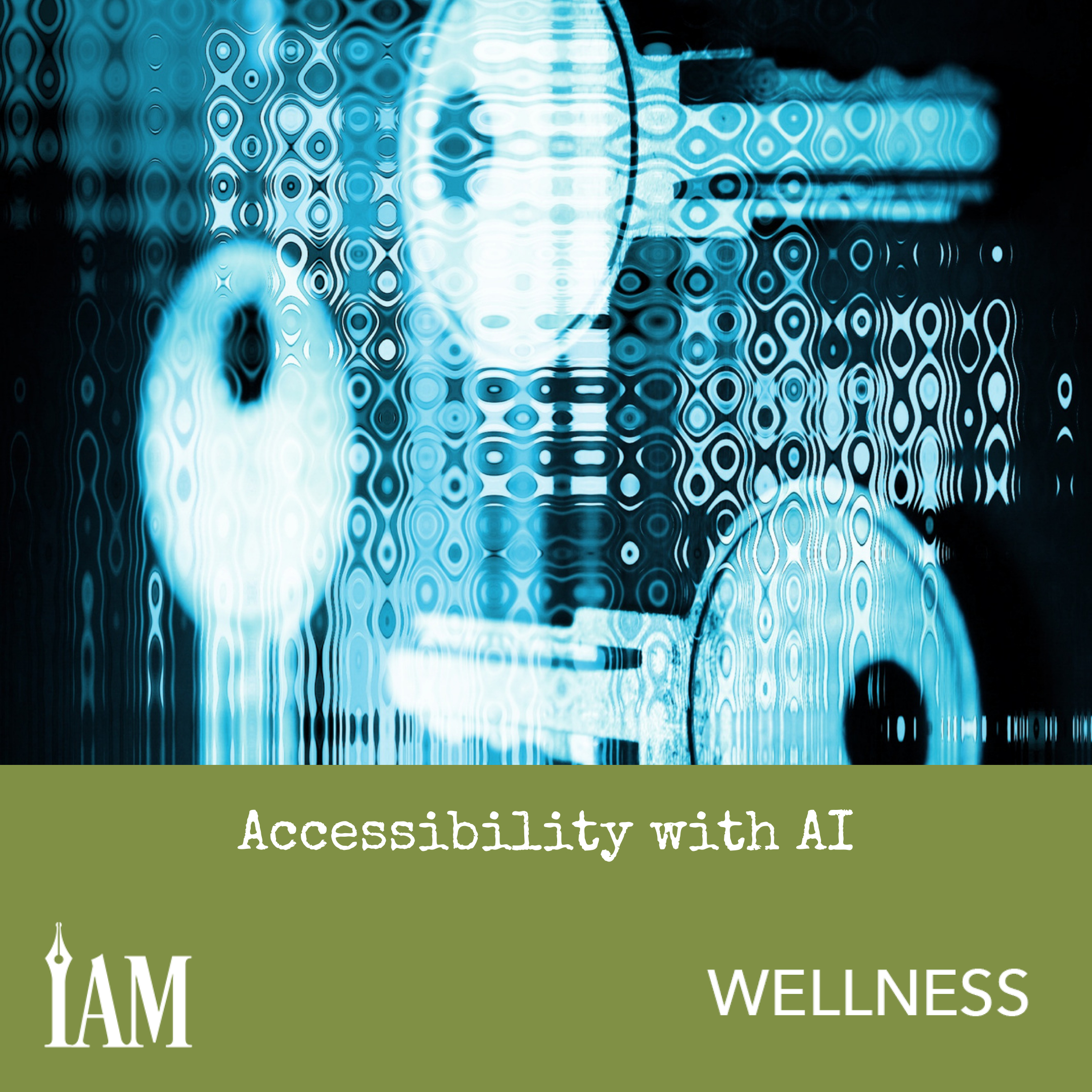
💡
The Rest of This Issue is for Paid Subscribers Only
Get more than just tips—get real results. As a paid subscriber, you'll unlock the full-color issue, VIP access to webinars and training, discounts on software and tools, and a community to support your journey.
Get more than just tips—get real results. As a paid subscriber, you'll unlock the full-color issue, VIP access to webinars and training, discounts on software and tools, and a community to support your journey.

